
The Project Gutenberg EBook of Bird-Lore March-April 1916, by Various This eBook is for the use of anyone anywhere at no cost and with almost no restrictions whatsoever. You may copy it, give it away or re-use it under the terms of the Project Gutenberg License included with this eBook or online at www.gutenberg.org/license Title: Bird-Lore March-April 1916 Author: Various Editor: Frank M. Chapman Release Date: May 31, 2012 [EBook #39854] Language: English Character set encoding: ISO-8859-1 *** START OF THIS PROJECT GUTENBERG EBOOK BIRD-LORE MARCH-APRIL 1916 *** Produced by Tom Cosmas, Larry B. Harrison and the Online Distributed Proofreading Team at http://www.pgdp.net
| VOL. XVIII No. 2 |
MARCH-APRIL, 1916 | 20c. a Copy $1 a Year |
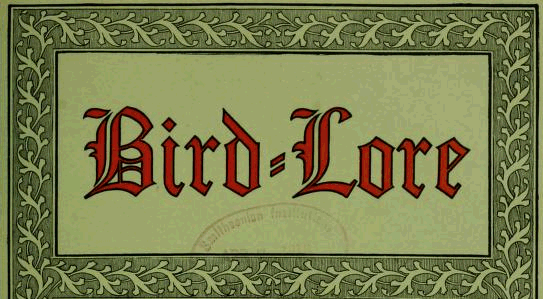
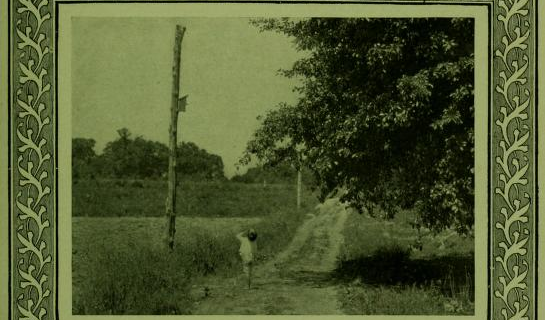
Edited by
FRANK M. CHAPMAN Published for the Audubon Societies BY HARRISBURG, PA. NEW YORK |
||
| COPYRIGHT, 1916, BY FRANK M. CHAPMAN | R. Weber. | |

March-April, 1916
⁂ Manuscripts intended for publication, books, etc., for review and exchanges, should be sent to the Editor, at the American Museum of Natural History, 77th St. and 8th Ave., New York City.
Notices of changes of addresses, renewals and subscriptions should be sent to
BIRD-LORE, HARRISBURG, PA.
Please remit by Draft or Money Order
Important Notice to All Bird-Lore Subscribers
ird-lore is published on or near the first days of February, April, June, August, October, and December. Failure to secure the copy due you should be reported not later than the 18th of the months above mentioned. We cannot supply missing copies after the month in which the number in question was issued.
Entered as second-class mail matter in the Post Office at Harrisburg, Pa.
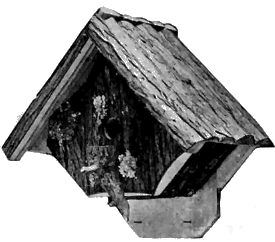
Send $1 for this famous
WREN HOUSE
Known as Jennie’s Choice
For three seasons “Jennie” preferred this House where there was a choice of fifty.
A. P. GREIM
“Birdville”
TOMS RIVER, N. J.
THE JACOBS BIRD-HOUSE COMPANY
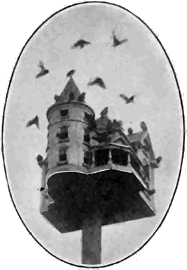
Our Indorsement.
First American enterprise for the manufacture of
Bird-Houses and Bird-Feeding Devices
Over 33 years’ experience by the Pres. Mgr.
Always leading in the Bird-House enterprise,
Jacobs Now Pays the Freight
to your nearest steam railroad freight station!
Twelve beautiful designs of colony houses for the Purple Martin.
Individual nest boxes for Wrens, Bluebirds, Swallows, Chickadees, Flickers, Titmice, Woodpeckers, etc.
Sheltered Feeding Devices and Food Tables, Cement Bird Baths and Drinking Fountains.
Genuine Government Sparrow Traps.
Direct from our factory to user at factory prices, thus giving customers the benefit of local dealers’ and agents’ commissions.
Mention this magazine and send 10 cts. for our beautifully illustrated bird-house booklet.
JACOBS BIRD-HOUSE COMPANY
404 S. Washington St., Waynesburg, Pa.

Just the Book to Interest Children in Bird Study
LITTLE BIRD BLUE
By William L. and Irene Finley
“No child can read this beautifully printed and illustrated book without having his love for the bluebird increased; even the adult will find much pleasure in text, illustrations, and exquisite make-up.”—Guide to Nature.
“One of the prettiest and most commendable of children’s books.”—St. Louis Republic. “It has the beneficial effect of intensifying our love of birds.”—Rochester Post Express. “Children could hardly have a more happy introduction to bird-study.”—Lexington Herald. |
“One of the most entertaining books for juveniles.”—Boston Globe. “Told in a manner to delight children.”—Zion’s Herald. “Mr. and Mrs. Finley have written the book with much charm, and woven into the story a great deal of bird-lore.”—Portland Evening Telegram. |
Profusely illustrated with drawings by Bruce Horsfall and photographs
by Mr. Finley. Price 75 cents net.
| 4 Park Street BOSTON |
HOUGHTON MIFFLIN CO., | 16 East 49th St. NEW YORK |
Everything from “Soup to Nuts” for the Birds
Try Evang Bros. Mixtseed for Native and Migratory Birds! Large size package, 50 cents.
230 Main Street Evanston, Illinois
Bird Gardening
ALTER M. BUSWELL, at present the Superintendent of the famous Bird Sanctuary of the Meriden Bird Club, is prepared to give expert advice on all matters pertaining to the attraction and protection of birds.
Address: Meriden, New Hampshire
I should be pleased to have any MUSEUM or HIGH SCHOOL desiring to secure an excellent ORNITHOLOGICAL and OÖLOGICAL COLLECTION for study and scientific purposes communicate with me.
GEO. W. AMES
No. 707 Washington Avenue
Bay City, Mich.
To Bird-Lovers
Use Comstock’s
BIRD NOTEBOOKS
Nos. 1 and 2
in your bird study
Each book has outlines for recording location, size, nesting, habits, etc., for use in the field. In addition, book No. 1 has 30, and book No. 2 has 28 outline drawings of birds (by Louis Agassiz Fuertes), on watercolor paper for recording the colors.
These books are used in quantity in classes, rural, city and normal schools and colleges.
Pocket size, 124 pages
30 cts. each, 50 cts. set of two
Send for circular of the Nature
Notebook Series
The Comstock Publishing Company
110 Roberts Place, Ithaca, N. Y.
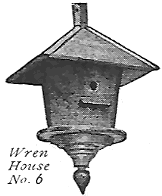
Do You Love Birds?
Encourage them to live in your gardens. Use our successful bird-houses for Wrens, Chickadees, Bluebirds and Purple Martins. Strongly made—well painted, to resist weather. Prices 35¢ to $10. Design illustrated $1 50. Our reliable wire Sparrow Trap endorsed by U. S. Government, $3 F. O. B. Dubuque. Write for free illustrated Folder No. 233-B.
Farley & Loetscher Mfg. Co., Dubuque, Iowa
Bird-Lores Wanted
(The publishers of BIRD-LORE respectfully urge subscribers who desire to have unbroken files of the magazine, to renew their subscription at the time of its expiration.)
Vol. I, Nos. 2, 3, 4; Vol. II, Nos. 1, 2, 3, 5; Vol. III, Nos. 4, 5; Vol. XIII, Nos. 1, 2. Philip Dowell, Port Richmond, N. Y.
Vol. I, Nos. 2, 3, 4, 6; Vol. II, Nos. 2, 3, 5; Vol. III, Nos. 1, 2, 4; Vol. IV, Nos. 1, 2; Vol. V, No. 1; Vol. VII, No. 1; Vol. IX, Nos. 3, 6; Vol. X, Nos. 1, 3, 4, 5; Vol. XII, Nos. 4, 6; Vol. XIII, Nos. 1, 2, 4; Vol. XIV, Nos. 1, 2; Vol. XV, No. 6. W. H. Broomhall, Stockport, Ohio.
Vol. XII, No. 5; Vol. XV, No. 6; Vol. XVI, Nos. 1, 2. Willard L. Metcalf, 140 W. 79th Street, New York.
Vol. III, No. 2; will pay $2. E. W. Hadeler, Painesville, Ohio.
Vol. XIII, No. 1. E. S. Wilson, 1044 Congress Ave., Indianapolis, Indiana.
Vol. X, No. 3; will pay $1. P. S. McGlynn, Moline, Ill.
Vol. XI, complete. A. J. Anderson, 1822 West Palmer Avenue, Sioux City, Ia.
Vol. XVI, Nos. 1, 2. A. D. Tinker, 631 S. 12th St., Ann Arbor, Mich.
Publisher’s Note.—Complete sets of Bird-Lore can no longer be supplied by the publishers, and now bring nearly three times the price at which they were issued. To subscribers who desire to complete their files, we offer the free use of our advertising columns.
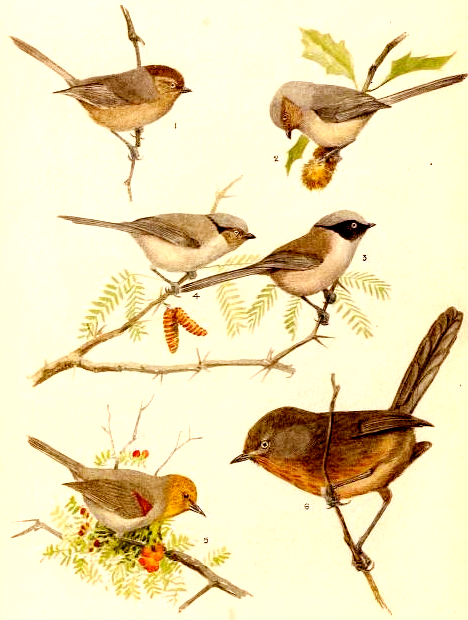
(One-half natural size)

A BI-MONTHLY MAGAZINE DEVOTED TO THE STUDY AND PROTECTION OF BIRDS
Official Organ of The Audubon Societies
| Vol. XVIII | March-April, 1916 | No. 2 |
The World’s Record for Density of Bird Population
By GILBERT H. GROSVENOR
Editor of the National Geographic Magazine
With photographs by the author
n the winter of 1913, our family bought a farm of one hundred acres, fifty acres in forest and fifty in fields, in Montgomery County, Maryland, about ten miles from Washington. We moved out in April. At the time, no members of the family, including my wife, six children, and myself, could name more than three birds—the Crow, the Robin, and the Turkey Buzzard. We had, however, become interested in birds, owing to our friendship for the Editor of Bird-Lore, and for other Audubon workers, and determined to see what we could do to get birds around the home, which we named ‘Wild Acres.’
The house is a typical old farmhouse, surrounded by an old apple and pear orchard, with vegetable garden and hedges, and open fields beyond. Surrounding the fields is a tract of fifty acres in woods, with a beautiful stream, and several springs scattered around in the fields and woods.
The first thing we did was to drive away the English Sparrows which had possession of the place. We got small shot-guns, and, whenever a Sparrow appeared, shot him. It wasn’t long before those that were not shot, left. We then made houses for Martins, Wrens, Bluebirds and Flickers, some of which were immediately occupied. We had such success that in the winters of 1914 and 1915 we put up more houses, and in the spring of 1915 had attracted so many birds around the house that Dr. H. W. Henshaw, the Chief of the U. S. Biological Survey of the Department of Agriculture, became interested, and delegated Dr. Wells W. Cooke to visit our place. Dr. Cooke was so impressed by the number of feathered friends that we had gathered around us that he urged me to make a census of the birds living on an acre or two adjacent to the house, as he thought it probable that a count would bring us a world record. The record up to this time was held by a family in Chevy Chase, Maryland, who had attracted thirteen pairs of birds to one half-acre.
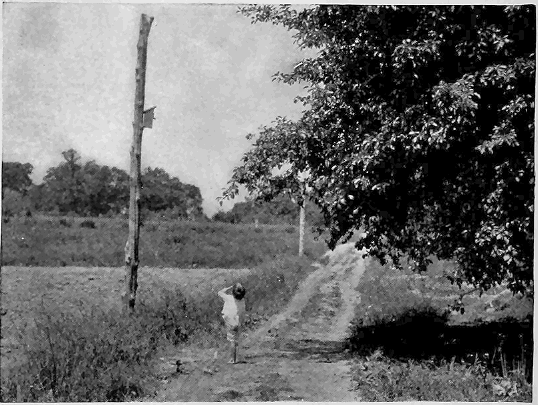
A BLUEBIRD'S NEST BOX, IN WHICH A PAIR OF BLUEBIRDS REARED THREE BROODS IN 1914, AND AGAIN IN 1915
The prospect of securing a world’s record was so inviting that, during the last week of June, 1915, I made a census of all birds nesting on the acre adjoining our house and barns, with the result that we found fifty-nine pairs of birds with young or eggs in the nest on that acre, the highest number of land-birds inhabiting one acre that has yet been reported to the Department of Agriculture or to any Audubon society. The details of the census are presented below:
LIST OF BIRDS NESTING ON ONE ACRE ADJACENT TO THE HOUSE AND BARNS
OF GILBERT H. GROSVENOR IN THE WEEK OF JUNE 15-21, 1915
(Only pairs whose nests were located with young or eggs in them are counted.)
| Flicker* | 1 | pair |
| Bluebird* | 1 | ” |
| Yellow Warbler | 1 | ” |
| Orchard Oriole | 2 | ” |
| Catbird | 2 | ” |
| Song Sparrow | 1 | ” |
| Chipping Sparrow | 2 | ” |
| Phœbe | 1 | ” |
| House Wren* | 14 | ” |
| Robin | 7 | ” |
| Robin | 7 | ” |
| Kingbird | 1 | ” |
| Martins* | 26 | ” |
| Total | 59 | pairs |
| English Sparrows | 0 | |
The asterisk (*) indicates pairs nesting in boxes put up by the family.
A similar census made of the second adjoining acre showed thirty-three pairs nesting in this area, as follows:
LIST OF BIRDS NESTING ON SECOND ACRE
| Song Sparrow | 1 | pair |
| Carolina Wren* | 1 | ” |
| Flicker* | 1 | ” |
| Maryland Yellow-Throat | 1 | ” |
| Brown Thrasher | 1 | ” |
| House Wren* | 4 | ” |
| Robin | 2 | ” |
| Catbird | 1 | ” |
| Chipping Sparrow | 1 | ” |
| Screech Owl* (no young in nest June 15, as brood had already left) | 1 | ” |
| Martins* | 18 | ” |
| Towhee | 1 | ” |
| Total | 33 | pairs |
| English Sparrows | 0 | |
 |
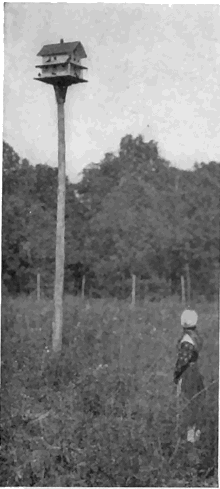 |
|
A MARTIN HOUSE IN THE MEADOW, ABOUT ONE HUNDRED YARDS FROM THE HOUSE It is advisable not to place the Martin box too near the house, for the birds begin to chatter long before dawn, and will awaken the household. |
MARTIN HOUSE IN THE HEN-YARD OCCUPIED BY TWENTY-FIVE PAIRS OF MARTINS IN 1914 AND 1915. The Martins are very efficient guardians of our chickens. I have often seen them drive the Hawks and Crows away. They hate Buzzards also. |
I attribute our success primarily to shooting the Sparrows and driving all cats away, to putting up many boxes, to keeping fresh water handy at all times, etc. We did everything we could for the comfort of our birds; for instance, we put on twigs little pieces of the oil-paper that our butter was wrapped in, and we left mud in convenient places for the Martins. The Catbirds used the oil-paper [80] for their nests, in fact, they used all kinds of scraps. Imagine the delight of the family when, on examining one of the Catbird’s nests in the autumn, we found one of the children’s hair-ribbons, and also a piece of an old dress of the baby!
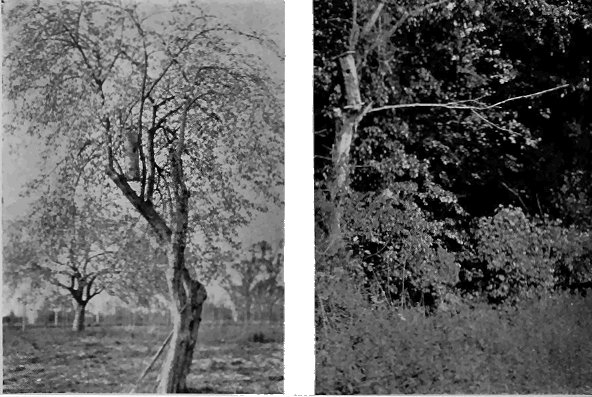 |
|
A SCREECH OWL'S NEST This box was put up for Flickers in the winter of 1914. Flickers took possession in March, but were driven out by Sparrow Hawks. But the Sparrow Hawks were frightened away two weeks later by the too great prominence of the position. Later a pair of Screech Owls adopted it for their home. Last winter we took the box down and carried it to the barn, to serve as a model for making other boxes. On opening it we found a live owl inside. |
A SPARROW HAWK’S NEST ON THE EDGE OF THE WOODS We had much difficulty in keeping red and flying squirrels out of the houses placed near the woods. In 1915 red squirrels drove out a pair of Flickers brooding in a box on the forest edge. |
We had read a great deal about how tame birds become when they are protected, but were constantly amazed at the quickness with which they perceived the care taken of them. Perhaps the most remarkable nest was that of a Phœbe, which was built under the cornice of the piazza, within reach of my hand. We had a little school in the morning at the house, and ten children were continually running up and down the piazza, shouting at the top of their voices, but the Phœbe went on building her nest, then hatched her eggs and fed her young without fear, though she could see everyone and everyone could see her.
I was also surprised to find how friendly birds, even of the same species, can become. For instance, we had fourteen pairs of Wrens on a single acre, some of the nests being not more than fifteen feet apart. We also had Robins nesting only twelve yards apart. The Bluebirds, on the other hand, do not like [81] each other and would not tolerate another pair of Bluebirds nearer than 100 yards.
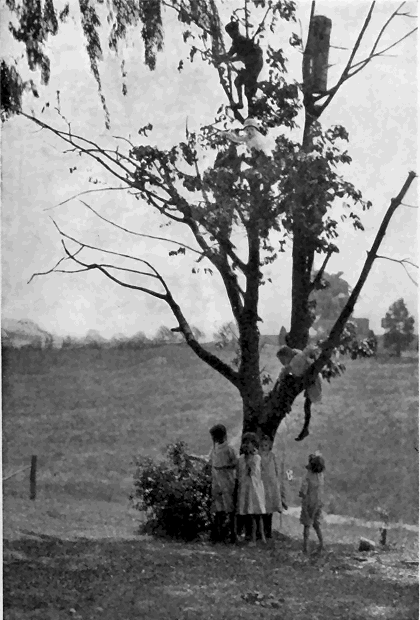
A FLICKER WAS NESTING IN BOX AND DID NOT STIR, THOUGH THERE WERE FIVE CHILDREN IN THE TREE AND FOUR BELOW WHEN THIS PHOTOGRAPH WAS TAKEN. (June 7, 1914.)
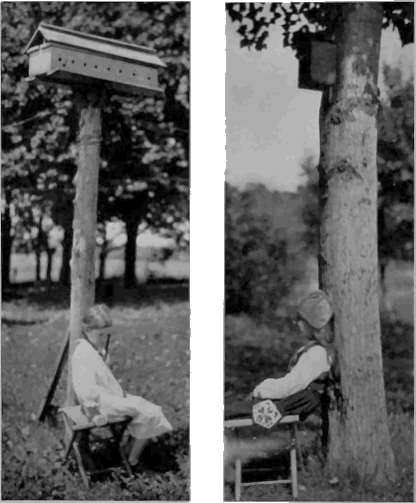 |
|
|
AN APARTMENT HOUSE FOR WRENS When we started building houses, we did not realize that Wrens would not share a house with another pair of Wrens. This house has rooms for eighteen pairs of Wrens. The room on the left was occupied in 1913, 1914 and 1915, and all the other rooms were vacant. Note Wren on box. |
A WREN HOUSE IN THE GARDEN Note the Wren on the perch. We had fourteen pairs of house Wrens nesting on one acre adjoining the house and barns in 1915. This is the largest number reported of Wrens living on one acre. |
The first year we had no Flickers, but there was a pair nesting in an old apple tree on our neighbor’s property. During the winter the tree was blown down and our oldest son obtained permission to get it. He cut out the portion of the tree which contained the nest, cleaned out the hole, and then hung the [83] nest in a dying cherry tree, as shown in our illustration. The nest was not more than ten yards from the house, but was taken possession of in 1914 and again in 1915.
The photographs illustrate some of our tenants. We are putting up this winter many more houses on the rest of the farm, as, up to this time, our efforts have been confined to the ten acres nearest the house.
 |
|
A FLICKER'S NEST BOX ON AN APPLE TREE ONLY TWELVE YARDS FROM THE HOUSE AND BORDERING THE DRIVEWAY. In this same tree, also, a pair of Robins and a pair of Chipping Sparrows nested in 1915. |
A BOX OCCUPIED BY FLICKERS AND WRENS When the Flickers came back the second year (1915), they tried to excavate a new door to their house, on the opposite side from that shown in the picture, but soon desisted, leaving a hole about 2 inches deep. Later a pair of Wrens built a nest in the new hole, so that in 1915 a brood of Flickers and a brood of house Wrens were living in the box at the same time. Note the Flicker’s head in the doorway. |
We have already found the following birds nesting on some part of the 100 acres of field and woods: Flicker, Robin, Catbird, Bluebird, Orchard Oriole, House Wren, Purple Martin, Summer Warbler, Brown Thrasher, Chipping Sparrow, Phœbe, Barn Swallow, Grasshopper Sparrow, Whip-poor-will, Towhee, Indigo Bunting, Black-and-White Warbler, Song Sparrow, Meadowlark, [84] Chat, Maryland Yellowthroat, Field Sparrow, Cardinal, Red-eyed Vireo, Ovenbird, Wood Thrush, Scarlet Tanager, Acadian Flycatcher, Great Crested Flycatcher, Mourning Dove, Kingbird, Red-headed Woodpecker, Wood Pewee, Bob-white, Chickadee, Titmouse, White-breasted Nuthatch, Carolina Wren, Mockingbird, Goldfinch, Crow, Bluejay, Downy Woodpecker, Hairy Woodpecker, Barred Owl, Screech Owl, Sparrow Hawk, Red-shouldered Hawk, Redstart, Yellow-throated Vireo, Cedarbird, Vesper Sparrow, Louisiana Water-thrush, and Ruby-throated Hummingbird.
We had, in 1915, seventy-five pairs of Martins in an area of approximately ten acres, and expect to have a great many more than this in 1916. We had one pair of Red-shouldered Hawks nesting in our woods, and kept them for two years; but they developed such fondness for poultry, being caught repeatedly thieving, that finally we had to shoot them.
We have in the woods a splendid pair of Barred Owls. They come around the barns at night, and I suspect them also of attempts at chicken-thieving, but they are too handsome and rare a bird in these parts to shoot. We have nothing good to say of the Screech Owl, which we suspect of having been the cause of the mysterious disappearance of many young birds from the nests.
If any one wants excitement, I suggest that he buy or borrow a stuffed Owl, and put it out in the garden in the daytime during the nesting season. All the birds in the neighborhood will soon congregate, and the children will learn the birds quicker than in any other way.
By GARRETT NEWKIRK
The Spring Migration of 1915 at Raleigh, N. C.
By S. C. BRUNER and C. S. BRIMLEY
he migration of birds at Raleigh, N. C, during the spring of 1915 was so unusual that it is believed that a short account, together with a list of the records, will be of interest to the readers of Bird-Lore. In considering the following remarks, it may be well to bear in mind that records of the bird migration in this locality have been made each year for the past thirty-one years. Also, the amount of time spent in making observations during the past season is significant. From March 19 to May 7, field trips were made by Mr. Bruner on forty-seven days out of a possible fifty. Prior to and after this period observations were made by him for several weeks at intervals of from two to four days. Mr. Brimley was in the field for twelve days from March 30 to April 28, but was unable to pay full attention to birds. The duration of each trip averaged about four hours, this figure not including the time spent in going to and from the city. Observations for the most part were made independently by each of the writers, and on lands differing somewhat in general character. It is believed that the great majority of species were recorded on as near the actual date of their arrival as it would ordinarily be possible to obtain them.
The most remarkable fact in connection with the season was the very great delay in the arrival of the earlier migrants and in the departure of the winter birds. This was very probably due almost entirely to the unusual weather conditions which seemed to prevail throughout the South during March and early April. March was abnormally cool, especially so during the latter part of the month. At Raleigh one-half of an inch of snow fell on the thirty-first, and this was soon followed by the most severe snowstorm on record for the month of April. On April 2, at 8 P. M., wet snow began to fall, and continued steadily until about 8 P. M. on April 3, the ground at that time being covered to a depth of about ten inches, the total fall being equivalent to thirteen inches of dry snow. In the wake of this storm came fair and very warm weather. By April 6 nearly all traces of snow had disappeared, and the birds began to arrive. Between April 6 and April 9, the Black-and-White Warbler, Louisiana Water-Thrush, Yellow-throated Warbler, Blue-gray Gnatcatcher, Maryland Yellowthroat, and White-eyed Vireo all reached Raleigh, these species being from nine to fourteen days late. Prior to this period the Chipping Sparrow had appeared on March 19—about two weeks late,—and the Blue-headed Vireo on April 1, this bird arriving only one week late. After April 6, the greater number of other species came in at about their usual time or a few days later, but several were decidedly early. The Kingbird reached Raleigh on April 12, the earliest date yet recorded in this locality. However, this was the only record for early arrival that was broken among the commoner species, although two others were equaled.
Six new records were established for late departures of winter birds, namely: Loggerhead Shrike, April 1; Fox Sparrow, April 6; American Pipit, April 6; Brown Creeper, April 19; Song Sparrow, April 28, and White-throated Sparrow, May 19. Two former records were duplicated and seven of the remaining fourteen species noted were from four to fourteen days later than the average. It is plain that species which leave normally before the sixth of April could have been delayed a few days by the severe weather of late March and early April; but it is not easy to understand how it could have affected, to any marked extent, the species which depart in late April and in May.
The migration at Raleigh was also characterized by an unusually great variety of species, including a number of very rare birds. A Black-crowned Night Heron taken on April 4 and a Bay-breasted Warbler observed on May 5 constitute new local records. Other rare or uncommon species worthy of especial mention are the Yellow-crowned Night Heron, Osprey, Black-throated Green Warbler, Yellow-legs, Pectoral Sandpiper, Bartramian Sandpiper, Cape May Warbler, Blue-winged Warbler, Chestnut-sided Warbler, Baltimore Oriole, Rose-breasted Grosbeak, and Wilson’s Warbler. The total number of species whose arrival was observed amounted to no less than sixty-eight in all, which is the largest number yet recorded at Raleigh during a single season. This fact can probably in no way be attributed to the abnormal weather conditions before mentioned (except possibly in the case of the Night Herons), but rather to the large amount of time spent in making observations. Also the fact that two observers were in the field did not play so large a part in this as might be expected, as one of them alone observed all but one of the sixty-eight species recorded.
A. COMMONER SPECIES
| I. Species normally arriving before April 1. | ||||||
| Name | Average date of arrival [1] |
Arrival 1915 | Days later or earlier than average. |
|||
| Chipping Sparrow | March | 7 | March | 19 | 12 | late |
| Yellow-throated Warbler | March | 24 | April | 7 | 14 | late |
| Blue-gray Gnatcatcher | March | 24 | April | 7 | 14 | late |
| Blue-headed Vireo | March | 25 | April | 1 | 7 | late |
| Pectoral Sandpiper | March | 25 | April | 13 | 19 | late |
| Louisiana Water-Thrush | March | 26 | April | 7 | 12 | late |
| Maryland Yellowthroat | March | 26 | April | 7 | 12 | late |
| Black-and-White Warbler | March | 27 | April | 6 | 10 | late |
| Black-throated Green Warbler | March | 27 | April | 10 | 14 | late |
| White-eyed Vireo | March | 31 | April | 9 | 9 | late |
| American Osprey | March | 31 | March | 28 | 3 | early |
| II. Species normally arriving from April 1 to 10 inclusive. | ||||||
| Tree Swallow | April | 3 | April | 13 | 10 | late |
| Lesser Yellow-legs | April | 3 | April | 13 | 10 | late |
| Barn Swallow | April | 7 | April | 13 | 6 | late |
| Green Heron | April | 9 | April | 14 | 5 | late |
| Parula Warbler | April | 10 | April | 15 | 5 | late |
| Whip-poor-will | April | 10 | April | 18 | 8 | late |
| III. Species normally arriving from April 11 to 20, inclusive. [87] | ||||||
| Redstart | April | 12 | April | 12 | 0 | late |
| Yellow Warbler | April | 14 | April | 17 | 3 | late |
| Prairie Warbler | April | 14 | April | 12 | 2 | early |
| Yellow-throated Vireo | April | 14 | April | 13 | 1 | early |
| Spotted Sandpiper | April | 15 | April | 13 | 2 | early |
| Hooded Warbler | April | 16 | April | 10 | 6 | early |
| Crested Flycatcher | April | 16 | April | 24 | 8 | late |
| Red-eyed Vireo | April | 16 | April | 20 | 4 | late |
| Wood Thrush | April | 16 | April | 11 | 5 | early |
| Chimney Swift | April | 16 | April | 13 | 3 | early |
| Ovenbird | April | 17 | April | 9 | 8 | early |
| Summer Tanager | April | 17 | April | 11 | 6 | early |
| House Wren | April | 17 | April | 20 | 3 | late |
| Ruby-throated Hummingbird | April | 18 | April | 14 | 4 | early |
| Kingbird | April | 19 | April | 12 | 7 | early |
| Catbird | April | 20 | April | 21 | 1 | late |
| IV. Species normally arriving later than April 20. | ||||||
| Yellow-breasted Chat | April | 24 | April | 27 | 3 | late |
| Solitary Sandpiper | April | 24 | April | 13 | 11 | early |
| Orchard Oriole | April | 25 | April | 27 | 2 | late |
| Wood Pewee | April | 25 | April | 27 | 2 | late |
| Water-Thrush | April | 27 | April | 23 | 4 | early |
| Black-throated Blue Warbler | April | 27 | April | 21 | 6 | early |
| Green-crested Flycatcher | April | 30 | April | 21 | 9 | early |
| Bobolink | May | 2 | May | 3 | 1 | late |
| Indigo Bunting | May | 2 | April | 27 | 5 | early |
| Blue Grosbeak | May | 3 | May | 1 | 2 | early |
| Black-poll Warbler | May | 4 | May | 3 | 1 | early |
| Kentucky Warbler | May | 5 | April | 23 | 12 | early |
| Yellow-billed Cuckoo | May | 6 | May | 14 | 8 | late |
B. RARER SPECIES [2]
|
|
|||||||||||||||||||||||||||||||||||||||||||||||||||||||||||||||||||||
[1] The average date of arrival was calculated from records made during the period 1884 to 1911 inclusive.
[2] This group includes species of which our records are too meager or too irregular to obtain an average as to time of arrival.
First Efforts at Bird Photography
By H. IRA HARTSHORN, Newark, N. J.
With photographs by the author
he accompanying pictures are the results of my first attempts at bird photography, and I want to let others know how much pleasure is to be derived from this method of studying birds. All the pictures I have taken so far are of the tame birds one sees every day around the house. That is, if one doesn’t live in too big a city; in which case a trolley to the suburbs will answer, as it did in my case.
My equipment, which includes a second-hand camera, two plate-holders, an electrical release, a flashlight battery, small satchel, flexible wire, etc., did not cost over $8.
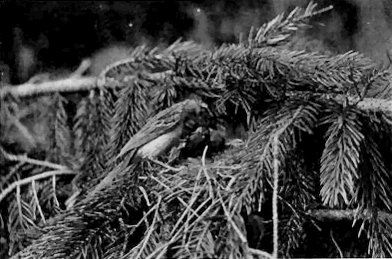
CHIPPING SPARROW FEEDING ITS YOUNG
The first nest I saw last year was a Chickadee’s nest. I found it on April 18. It was still cold, with not a leaf on the trees. The two birds were taking out chips from the top of a birch stump, which was about seven feet high. The hole was about eight inches deep. There was still no lining in the nest, so I knew that the birds had not prepared it for the reception of the eggs.
I visited it again on April 26, and expected to see two eggs in the little home; but, when I arrived there, I found that the nest had been broken off at the very bottom of the eight inches already dug. This was caused by the Chickadees’ digging too close to the rotten bark, when the first gust of wind probably broke it. Much to my delight, the birds were not daunted by this misfortune, but kept on building. On April 24, the hole was started the second time. A [89] friend saw the Chickadees begin the hole. On April 26, the hole was six inches deep! The birds had dug through fourteen inches of wood to make their home!
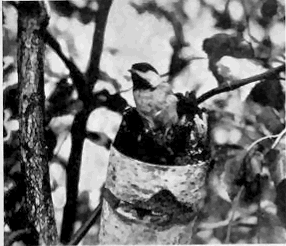
CHICKADEE LEAVING ITS NEST TO FORAGE FOR A FAMILY OF EIGHT
On May 2 the nest was finished, and on May 9 there were eight eggs in the little bit of a hole that could hardly hold the mother bird.
May 23, I took my camera with me to the nest. I expected that the young birds would be out by that time, and that the old birds would be flying in and out with food, giving me many opportunities for photography. I looked in the nest and saw that every egg was hatched, so I proceeded to set my camera about two feet away, when who should appear on the ground-glass but one of the parents, with a mouth full of struggling little green caterpillars. She, if it were the female, looked at the camera a second or two, then, without another thought of the outside world, hopped down into the nest and fed her young.
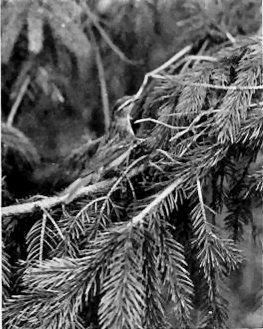
CHIPPING SPARROW APPROACHING ITS NEST
The camera arranged, I was just about to seek concealment behind a bush, when both of the parent birds flew near the nest with food. I stood very still. One of the birds, the male, I think, stopped too, but the other one flew right into the nest. She soon came out, and stood on the very point I had the camera focused. Very slowly I put my hand up to the shutter-release, expecting the [90] bird to fly any minute; but at last I reached it and, click, I had my first ‘close up’ bird picture. And it was the best one, too; for although I took six or seven others, they did not turn out so well as the first one.
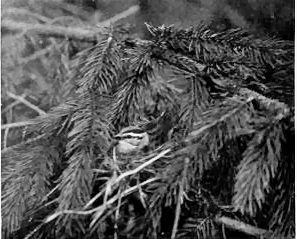
CHIPPING SPARROW BROODING
May 31, I went to take the pictures of the little Chickadees, but found that they were still too small to handle. I was not able to go again, but my friend reports that the whole family of eight young left the nest, and were very healthy-looking little birds. This nest was situated on the edge of a woods at Verona, N. J.
During the two weeks’ vacation at Fredon, Sussex Co., N. Y., I found twelve nests, a list of which follows. All but three were found on a farm.
One Robin’s nest, containing one egg. Deserted for unknown cause.
Two Field Sparrows’ nests. Each contained young, almost full-grown birds. One nest had an unfertile egg in it.
One Barn Swallow’s nest, containing four eggs.
Two Red-winged Blackbirds’ nests, each with four eggs. Both nests were broken up. One was entirely empty and the other contained the shells of the eggs. I could not find out the cause of this double tragedy.
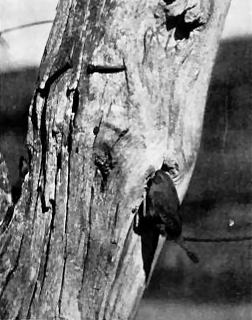
A HOUSE WREN ENTERING ITS NEST IN A FENCE-POST
Two House Wrens’ nests. Both of these were in fence-posts. I caught one bird with the camera just as it was entering the nest.
Two Chipping Sparrows’ nests. One was in an unusual place, on the limb of a Norway spruce that projected over the porch roof. I got some very good photographs of this family, which consisted of the parents and three young. The young were hatched on June 6, and they left the nest on June 15.
One Kingbird’s nest, containing three eggs, was on a limb of a willow tree that extended over a pond about ten feet. The nest itself was three feet above the water.
One Flicker’s nest. I could not determine the number of young in this nest, but I knew they were there by their hissing at a shadow over the entrance to the nest.
This year the Bobolink appeared in the neighborhood of Fredon for the first time in at least four years, if not more.
Of all the songs of birds I have heard, I like the Bobolink’s the best.
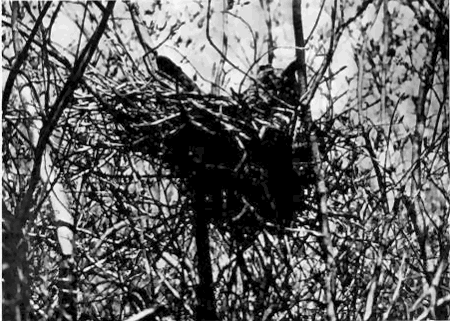
LONG-EARED OWL ON ITS EGGS IN AN OLD CROW'S NEST
Photographed by H. and E. Pittman, Wauchope, Saskatchewan.
The Interesting Barn Owl
By JOSEPH W. LIPPINCOTT, Bethayres, Pa.
With a photograph by the author
he Barn Owl commands my respect. He is the greatest mouse-eating machine I have yet encountered, and as such surely deserves every consideration in these days of crop destruction by rodents. Like most Owls, he does not allow his presence long to remain unsuspected. A loud, harsh scream after nightfall, repeated at the right intervals to keep one awake and echoed by the young Owls when they appear, is his greeting. And well may the little mice shiver in their poor retreats!
I heard the good old Barn Owls again and again during early spring nights, and later found that two, or perhaps more, young ones were generally in or about a hemlock grove not far from the creek and the swampy meadows that make such ideal feeding-grounds and are, in fact, the nucleus of the rodent hosts that spread over the neighboring farms each summer. It was by mere accident, however, that I found a nest.
A neighbor was planning a greenhouse on the site then occupied by his young chickens and, to give security to the glass, cut down a great storm-battered and fire-scarred buttonball tree that stood at one end of his farm buildings. Down it came with terrific force, but without killing three young Barn Owls, which were able to give one of the workmen a big scare when he climbed over the top. And this happened in the middle of August, when one brood was already in the woods!
They were in a deep, dark, ill-smelling hollow, and a weird-looking trio indeed with the white down still clinging over the yellow-brown feathers. What startled the workman was a splendid series of hisses; for they understood how to make the sound about as wickedly as the most poisonous serpent.
A little Owl is generally all grit, and these were the grittiest, bramble-footed propositions I ever expect to handle. Their big eyes kept an unwinking glare fixed on each one who came near, and they leaped like lightning, often all three together, at a hand thrust within reach. It would have been very comical except for the bitter earnestness which the poor little fellows put into their defense, making one feel sorry for them when double gloves prevailed, and they were deposited in a chicken-coop nearby, to prevent interference with the chopping. Then, for hours after the moving, it seemed as if steam were strangely and violently escaping from an ordinary chicken-coop, much to the astonishment of visitors.
Around the tree were many of the small masses of fur and bones which Owls disgorge a few hours after meals. These show very well what animals have been taken and, in this case, were most interesting, since the dozens I examined contained the remains of field mice, deer mice, shrews, and moles only. No rabbits, no squirrels, no insects, no little birds! Indeed, there was [93] not a feather of any kind, although the little chickens had been running about and roosting all spring and summer within a few feet—alluring, easy and constantly announcing their presence by seductive peeping.
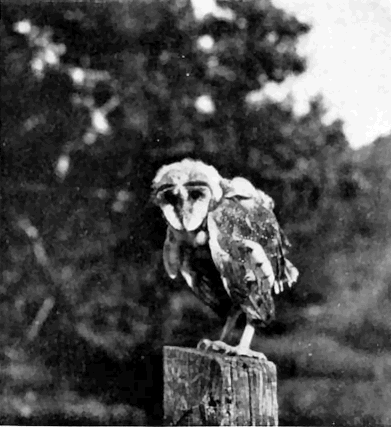
A YOUNG BARN OWL
The old hollow must have suffered long use. It opened toward the south through a large limb hole about thirty feet from the ground, and also upward through the broken top of the tree; though that exit was not used, and probably only served to let in a veritable deluge of water during the thunderstorms. No doubt, too, the young Owls amused themselves watching the clouds and the stars pass slowly over their heads day by day, with the added excitement of a Hawk, Buzzard, or smaller bird now and then. They rested on layers of debris which, when examined, showed that honey bees had once been tenants, and later bats and generations of Owls, perhaps many other birds, for hollows have a strange, interesting history.
The birds themselves seemed about the size of old ones without the full feathering, strong muscle and weight. They were so queer and wore such [94] humorous expressions whenever approached that, from the first, they would have been objects of continual interested observation, were it not for the rather discouraging fact that this almost always brought on a quarrel. The bright light and excited feelings seemed to confuse one so much that he would mistake the others for enemies and pounce on them. This caused equally fierce retaliation every time, and resulted in all three being scratched about the thighs. Darkening the coop remedied this.
It impressed me then as strange that, with all the birds’ show of aggressiveness, there was no snapping of beaks nor marked disposition to bite; but I later found that they did not have the same strength in their beaks as most varieties of Owls, particularly the Great Horned Owls, which crush the skull of a rabbit with such ease. This, I suppose, has something to do with the species’ love of very small mammals, which can be torn to pieces and swallowed without trouble by those queer cavernous mouths. Their hooked claws, which gripped me on several occasions, were all right, though and as sharp as needles.
The youngsters were left severely alone until evening, when, with the lessening light, came a quick change. They seemed to lose some of their fear, and to be expectantly listening for something. Every now and then one would utter a rasping cry, which blended harmoniously with the insect chorus and yet could be heard a long distance.
Just as the sun set and the glow still spread over the west, the cries became very insistent, and a shadow seemed to pass for an instant over the coop as one of the parents flew quietly into a locust tree nearby, and stood there close to the trunk, a mouse dangling from the left foot. It soon flew out and circled noiselessly, only to disappear very soon, much to the disgust of the coop occupants. Several minutes elapsed, the evening silence broken only by the rasping call and the drum of the katy-dids; then an old Owl circled by bearing a mouse in its beak. It may have been the same bird and the same mouse, the deepening shadows making it impossible to see accurately.
The night being dark, I left my hiding-place and the birds until morning, when it was surprising to find only the smallest of the three in the coop, and that dead. The other two had escaped; but how they squeezed beneath slats which allowed only the tiniest chicks to go through will ever be a mystery to me. I could not even pull out the remaining one. It was much less developed than the other two, both in size of limb and feather, and had evidently succumbed to the effects of the frightful fall, though its body showed no bruise.
I hunted around the debris of the felled trees, and finally spied the others, which had done some expert climbing and hidden in the darkest corners, one beneath a tree trunk, the other in a leafy top where it had evidently stayed all night, as evidenced by a kind of bed stamped down and lined with surplus food carried there by the parents. Such a supper! three particularly fine meadow mice and a fat star-nosed mole, all freshly killed and whole.
The youngsters, which at first crouched silently, were in a very bitter frame [95] of mind, so I carried them out by the wing tips—the only satisfactory way I found of handling such a brambly article—and later made them stand in the light for a photograph—a difficult matter, because they ran with all speed for the wood-pile as soon as released. Just as I thought I had them, after many attempts, one mistook the other for a foe, and, without preliminaries, went for him. However, the other one met the rush feet first and seized the attacking claws before they hit, practically holding down his brother by each foot while he glared into his face in comical fashion, and hissed for all he was worth. This holding hands continued with much comical shaking of heads, until both birds suddenly struck at each other somewhat as roosters do; then they held hands again until separated and put into a deep open-top box for safe-keeping. If left free, dogs, cats, or opossums would most likely have found them through the strong odor so noticeable about young birds of prey. The mice were, however, first cut into pieces and thrust down the apparently hungry birds’ throats, while each was held by his feet and neck.
Every night after that the youngsters were visited and fed by the devoted old ones, and always it was with mice of some kind or moles—principally meadow mice, house mice, white-footed mice, shrews and ground moles—as many as eight sometimes, as shown by the disgorged pellets or uneaten bodies.
The parents also scrupulously cleaned the old box each night. They lived in the hemlock wood across the narrow valley, but in what tree I could not discover. One would appear soon after sunset with some kind of mouse, and by eleven o’clock had apparently satisfied the youngsters’ hunger, for the rasping cries would usually cease and an occasional louder and clearer cry of the old birds pierce the darkness.
One fine morning found the youngsters gone. Day after day they had tried to jump out of the box, each time coming a little closer to the edge. After this they could be heard calling in the evenings, and sometimes until dawn. Always in the wood, they perched high up side by side or on nearby limbs, and lazily relied on their parents to keep up the good work of providing mice. On dark nights they called much longer than on moonlight nights, which convinced me that the hunting was more difficult then.
Occasionally a parent could be seen standing always very erect on the barn gable overlooking a truck-garden, but usually it would watch from a tree in the marshy meadows, now and then dropping to the ground and staying there a considerable time as if hunting on foot among the grass clumps, a method which, from the great agility of the young when pursued on the ground and in the brush piles, I can well imagine no cat could improve on.
I tried without success to draw them by imitating their strange cry, and also a mouse’s squeak made by sucking loudly on the back of the hand. A Screech Owl and many wild animals would take instant notice of the latter, but not the Barn Owls. Even a rat caught in a trap failed to entice these birds, though several Screech Owls responded at once.
But who has stirred a Barn Owl? Over the dew-laden meadows he stands guard, or perhaps at the edge of the moonlit corn-fields, waiting for the only prey that seems to interest him. He knows the country like a book, the runways of the meadow mouse, the house mouse’s path from corn shock to corn shock, the mole’s early morning starting point.
Under the old buttonball tree the broods of young chickens ran from early morning to night. The owner felt that the large Owls were a menace to his flock and watched for them with a gun. But, with the fall of the old tree and a study of their food, a new light has spread to every farm in that vicinity.
I heard the young Owl’s last ‘rasp’ on October 16; it was full of the weird power which thrills one in the dark hours. A few minutes later, a big bird flew low toward the orchard—the young Owls had taken to hunting at last.
The Migration of North American Birds
Compiled by Prof. W. W. Cooke, Chiefly from Data in the Biological Survey
With a drawing by Louis Agassiz Fuertes
(See Frontispiece)
THE BUSH-TIT
All of the forms of Bush-Tits in the United States are non-migratory. The present species, which is better known by the name of the Least Bush-Tit, is confined to the Pacific Coast, where it ranges from northern Lower California to southern British Columbia. This is the range of the typical form (Psaltriparus minimus minimus), while a subspecies called the California Bush-Tit (Psaltriparus minimus californicus) occurs over much of eastern California east of the Sacramento Valley, from the southern end of the Sierras nearly to the Oregon line. A third form, or subspecies, the Grinda Bush-Tit (Psaltriparus minimus grindæ), is confined to the southern end of Lower California.
THE LEAD-COLORED BUSH-TIT
The southern boundary of the range of the Lead-colored Bush-Tit (Psaltriparus plumbeus) is found in western Texas, northern Mexico, southeastern to northwestern Arizona, and the Providence Mountains, California. Thence it occurs north to central and northwestern Colorado, northern Utah and northwestern Nevada. A few individuals have been noted in southwestern Wyoming and southeastern Oregon.
LLOYD’S BUSH-TIT
Scarcely coming across the boundary from its real home in northern Mexico, the Lloyd Bush-Tit (Psaltriparus melanotis lloydi) occurs in the southern part of the mountains of western Texas and barely crosses the line in southwestern New Mexico.
Confined to the borderland of the southwestern United States, the Verdin in its typical form (Auriparus flaviceps flaviceps) is one of the most interesting birds of the desert and semi-arid districts, and is non-migratory. It ranges north to southeastern California, southern Nevada, northwestern Arizona (and extreme southwestern Utah), southwestern and southeastern New Mexico, western and southern Texas, and south into northern Mexico and the northern half of Lower California. The southern half of Lower California is occupied by a subspecies called the Cape Verdin (Auriparus flaviceps lamprocephalus).
THE WREN-TIT
The known ranges of the various forms, or subspecies of the Wren-Tit are given in the following paper. All the forms are non-migratory.
Notes on the Plumage of North American Birds
THIRTY-SEVENTH PAPER
By FRANK M. CHAPMAN
(See Frontispiece)
Bush-Tit (Psaltriparus minimus and races. Fig. 1). The Bush-Tits of this group may be known by their brownish crown. The male and female are alike in color; the young bird closely resembles them but has the crown somewhat darker, and the winter plumage differs from that worn in summer only in being slightly deeper in tone. Three races of this species are known: The Bush-Tit (P. m. minimus) of the Pacific coast from northern Lower California to Washington, in which the crown is sooty brown; the California Bush-Tit (P. m. californicus), which occupies the interior of California and Oregon, and has the crown much brighter than in the coast form; and Grinda’s Bush-Tit (P. m. grindæ), a form of the Cape Region of Lower California with a grayer back.
Lead-colored Bush-Tit (Psaltriparus plumbeus. Fig. 2). The gray crown, of the same color as the back distinguishes this species from the Bush-Tits living west of the Sierras. The male and the female are alike in color; the young is essentially like them, but has less brownish on the sides of the head, and there are no seasonal changes in color.
Lloyd’s Bush-Tit (Psaltriparus melanotis lloydi. Figs. 3, 4). Lloyd’s Bush-Tit is a northern form of the Black-eared Bush-Tit of the Mexican tableland. Occurring over our border only in western Texas, southern New Mexico, and southern Arizona, it is rarely observed by the field ornithologist. The adult male may always be known by its black cheeks; and when the female has any black on the sides of the head (as in Fig. 4), no difficulty is experienced in identifying her. But immature males and often some apparently adult females are without black, and they then so closely resemble the Lead-colored Bush-Tit that it is impossible to distinguish them by color alone.
Verdin (Auriparus flaviceps. Fig. 5). When it leaves the nest, the young Verdin is a gray bird with no yellow on its head or chestnut on its wing-coverts, but at the postjuvenal molt both yellow head and chestnut patch are acquired, and the bird, now in its first winter plumage, cannot be distinguished from its parents. These closely resemble each other, but the female sometimes has less yellow on the head. After the colors of maturity are acquired, they are retained, and thereafter there is essentially no change in the Verdin’s appearance throughout the year.
There are but two races of the Verdin. One (A. f. flaviceps) occupies our Mexican border from coast to coast. The other, the Cape Verdin (A. f. lamprocephalus), a smaller bird with a brighter yellow head, is found only in the Cape Region of Lower California.
Wren-Tit (Chamæa fasciata. Fig. 6). The Wren-Tit enjoys the distinction of being the only species in the only family of birds peculiar to North America.[99] It is restricted to the Pacific coast region from northern Lower California north to Oregon. While it presents practically no variation in color with age, sex, or season, it varies considerably with locality, four races of it being recognized. Since they are non-migratory, the purposes of field identification will best be served by outlining their distribution as it is given in Dr. Grinnell’s recent, authoritative ‘Distributional List of the Birds of California’ as follows:
Pallid Wren-Tit (Chamæa fasciata henshawi). Common resident of the Upper Sonoran Zone west of the deserts and Great Basin drainage from the Mexican line through the San Diegan district, northward coastwise to San Luis Obispo and San Benito counties, and interiorly along the western foothills of the Sierra Nevada to the lower McCloud River, in Shasta County; also along the inner northern coast ranges from Helena, Trinity County, and Scott River, Siskiyou County, south to Covelo, Mendocino County, and Vacaville, Solano County. The easternmost stations for this form are: vicinity of Walker Pass, Kern County, and Campo, San Diego County.
Intermediate Wren-Tit (Chamæa fasciata fasciata). Common resident of the coast region south of San Francisco Bay, from the Golden Gate to southern Monterey County; east to include the Berkeley hills and at least the west slopes of the Mount Hamilton range.
Ruddy Wren-Tit (Chamæa fasciata rufula). Common resident of the humid coast belt immediately north of San Francisco Bay, in Marin, Sonoma, and Mendocino counties. Northernmost station for this form: Mendocino City.
Coast Wren-Tit (Chamæa fasciata phæa). Fairly common resident locally in the extreme northern humid coast belt. Humboldt and Del Norte Counties.
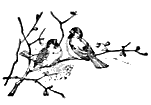
Through a typographical error the Tree Sparrow was included in the Census of Mrs. Herbert R. Mills of Tampa, Florida, published in the January-February, 1916, issue of Bird-Lore. The record should have read Tree Swallow.—Editor.
The greatest problem with most of our bird clubs seems to be: What can we do to make our meetings interesting, so that all the members, especially the younger ones, will be anxious to come?
In planning for parties, picnics, or other entertainments of that sort, we usually expect to have everyone present take a part in whatever games or sports there are, and, no matter how often we have them, there is never any question but that all who can do so will be there. I believe that bird-club meetings can be made equally attractive if we go about them in the same way, rather than to plan some sort of entertainment where only a few are to have a part, as is usually the case.
There is almost no limit to the number of interesting and instructive things we can do, and it will be possible for even the more advanced bird students to learn something new at nearly every meeting.
Every member should have a notebook for keeping a record of the birds seen and identified, with any new or interesting things observed, for comparison with others at each meeting; and each member should have a standing in the club according to the number of birds identified and the amount of work done for the birds. This will be an inducement for each member to do something or learn something new before the next meeting, and to be present at all the meetings, to learn what others have done. It will also be found helpful in learning about birds and in remembering what is seen; for, unless we have some special reason for noting carefully all that may be seen on our walks, even the most interested observers will miss many things, and will forget much of what they did see.
When about to start on a walk of about three miles, one bright pleasant morning last June, I decided to keep a list of all the birds seen and heard from the time I started until I returned. The walk was finished between twelve and one o’clock, when most of the birds were quiet and few were seen; yet I saw 105 birds on the trip, and had a good idea of the number and variety of birds one might see at this time of the year. If I had kept no record of the number, I could not have told how many I was likely to see, or which species would be seen oftenest. All such things will prove interesting at the meetings, and will add largely to our knowledge of birds in the course of a year.
In winter, we should note the feeding habits of the different birds and the number and kinds of winter visitors seen; it is also a good time to make a study of nests, where they are placed, and the material used in each.
In summer, there will be something for every day if we have our eyes open; nesting habits, bird-baths, and occasionally some rare migrant to tell about. It would be impossible to give a complete list of the interesting things to be seen at this time.
Every club should own a few good reference books, and have them at their meetings, to settle any questions that may arise. The ‘Color Key to North American Birds,’ by Chapman, will be found useful for identification, ‘Wild Bird Guests,’ by Baynes, for matters pertaining to bird clubs and bird protection, also ‘Useful Birds and their Protection,’ by Forbush.
There are many others that would prove beneficial, but these three are almost indispensable, if we would learn the ways of our wild bird friends and what we can do to help them.
It is understood that every family of bird lovers will be subscribers to Bird-Lore, for few would be willing to miss the interesting bits of information to be found in every number of this bird magazine.
Selections from Bird-Lore, the Audubon Leaflets, books on Nature by standard authors, and occasionally articles from some of the popular magazines, might be read at each meeting. This will prove a very interesting part of the program, and there will always be material enough to fill out any schedule.
Good plates of birds like those obtained with the Audubon Leaflets and the set published with the ‘Birds of New York’ will help in identifications, and, as the cost is very small, every club should have at least one set of each.
If we can get our clubs once started along these lines, it seems possible that it might become more of a problem to find time for everything than to find something to do.
One year’s course in a bird club of this kind should give every member a fairly good knowledge of what we can do for the birds, and what they are doing for us.—W. M. Buswell, Superintendent Meriden, (N. H.) Bird Club.
Ornithological Possibilities of a Bit of Swamp-Land
For several years, I have had a bit of swamp-land under my eye, especially during the cooler months. It is not exactly a beauty-spot, being bordered by ragged backyards, city dumps, a small tannery, and a dismantled factory, formerly used by a company engaged in cleaning hair for plasterers’ use.
A part of the surface is covered by cat-tails, the rest by a mixed growth of water-loving shrubs, as sweet-gale, leather-leaf, andromeda, and other shrubs which like to dabble their roots in ooze. A brook, connecting two large ponds, runs through the swamp, giving current and temperature enough to make certain a large amount of open water, even in the coldest weather.
A little colony of Wilson’s Snipe have made this swamp their winter home for at least fifteen years, and probably much longer. Song, and generally Swamp Sparrows can be found here all winter. This winter, we have a Green-winged Teal, finding feed enough to induce her to remain; and over beside the cat-tails, about some fallen willows, a Winter Wren seems much at home.
During recent years, a sort of beach, made by dumping gravel to cover refuse from the hair factory, has been a favored feeding place for various Sandpipers, as well as the Snipe. The last of the Sandpipers leave in November, while the Snipe remain.
Bitterns and Black-crowned Night Herons drop in during the fall and summer, and our increasing Ring-neck Pheasant, the gunner’s pet, loves to skulk around the edges.
Tree Sparrows, Goldfinches, and their kin attract an occasional Butcherbird and the smaller Hawks, Pigeon, Sparrow, and Sharp-shin in season.
Early spring brings a host of Blackbirds, Redwings, Bronzed Grackles, and Rusties; while a Cowbird hung about with some English Sparrows, until Thanksgiving time, this year.
We are always on the lookout for something new to turn up in the swamp, and are seldom disappointed. For so small a place, not over five acres, it surely is a bird haven; especially does it seem so when, but a few rods away on the nearby ponds, the ice-men are harvesting twelve-inch ice. Naturally, local bird-lovers are praying that the hand of “improvement” will be stayed a long time in wiping out this neglected little nook.—Arthur P. Stubbs, Lynn, Mass.
My neighbor one block to the north, Professor E. R. Ristine, who gives me leave to use his name in the present connection, finally lost his patience with English Sparrows (Passer domesticus), on or about May 15, 1915. The fact that [102] an elderly person sharing the home with his family could not sleep at reasonable hours on account of Sparrow chatter was an element in the decision to which he soon came. For into his hands fell an advertisement of a Sparrow trap, just such a two-funnel wire affair as was described and recommended as early as 1912 by the Department of Agriculture in Farmers’ Bulletin 493. On May 20, 1915, the trap arrived, and was duly installed and baited. It was at first placed on the ground in the small chicken-yard at the rear of the house, and the outer funnel was baited with a small amount of cracked grain, the finer “chick-feed” proving to be most efficacious. The location of the trap was changed at different times during the spring, summer, and fall, and the total results on the Sparrow population were satisfactory beyond expectations.
By June 11, only twenty-two days after the trap was set out, 78 Sparrows had passed the fatal inner funnel of that simple contrivance, and at this, fortunately for the accurate details of the present account, my neighbor’s interest was aroused to know precisely what the powers of his most recent purchase might really be. With a pencil he marked thereafter on the siding of his hen-house the mortuary record: 6/13—84, 6/17—100, 7/9—202, and so forth. That is to say, a total of 202 birds had been gathered in by July 9, fifty days after the trap was put into action, or an average of a little more than four per day. This rate of destruction was much increased during the following month, the 300 mark being passed on July 27, and the 400 mark on August 11. The rate of capture then declined, and it was not until September 18 that the figure 508 was registered. The trap remained set until December 5, at which time the deadly record stood at 597. A few dozens more had entered the trap but escaped through the insufficient latching of the “clean-out” door. After December 5 heavy snows fell, followed by sleet storms, and my neighbor temporarily placed his trap out of service on a back porch.
A few facts in connection with the above record will prove of interest. The heaviest catches were made when the currants became very ripe and the trap was placed under the laden bushes. Fewest Sparrows were caught when the sweet corn in the garden was in the milk stage, the birds preferring the contents of the juicy kernels to the dry grain with which the trap was baited. The largest catch on any one day was 20 birds, this number being reached on two different dates, June 27 and August 4. The Sparrows seemed to arrive in flocks of greater or less size, and the record would mount rapidly until these were gathered in. Then, for several days possibly, no birds at all would be trapped. And the fine feature of the entire season’s experience was that this trap caught English Sparrows and no other bird whatsoever. The only exception to English Sparrows was a single hoary old house rat that had evidently followed a Sparrow in; at any rate, the latter was found partially devoured.
Relief from the Sparrow nuisance began to come to our neighborhood about the middle of August, after full 400 of the noisy chatterers had fallen victim to the innocent-looking wire cage. And by the time the Indian summer days of October came, the English Sparrow tribe in our part of town had dropped from the status of “abundant” to only “fairly common.” Indeed, I have not seen more than six individuals together in our end of the little city at any time in the last three months.
Is it possible that my neighbor’s experience was out of the ordinary? I do not see why it should be, but I have found a similar record only in the above-mentioned Farmers’ Bulletin, where the capture of 300 Sparrows in six weeks in the Missouri Botanical Gardens, St. Louis, is noted. If it is at all typical of what may be accomplished, then one or two things seem clear. An easy method is at hand for holding in check the Sparrow nuisance and more attention should be given to Farmers’ Bulletin 493 than seems thus far to have been accorded this worthy publication.—Charles R. Keyes, Mt. Vernon, Iowa.
[We are indebted to Prof. M. H. Saville for a copy of ‘El Comercio’ for October 18, 1915, a newspaper published at San Pedro Sula, Honduras, which contains the following account of a migration tragedy.—Editor.]
“At midnight, on October 10, 1915, there commenced to appear groups of birds flying in a southerly direction. At the time darkness set in, we began to hear the call of a great number of birds that were circling constantly over the city. This avian invasion increased considerably during the night. The main part of the army of invasion crossing the Gulf of Honduras arrived in the evening off the coast of Puerto Cortes. These birds do not travel by day, but follow the eastern shore, guided by certain groups that, toward night, exhausted, ceasing their flight, turn inland. The bright rays from the electric lights projected high in among the clouds, serving to indicate the position of San Pedro Sula and, attracted by its splendor, the bird emigrants, greatly fatigued by their vigorous exercise in the long flight against contrary winds in their travel across the Gulf of Mexico (approximately 700 miles), their short stay in Yucatan, and their flight across the Gulf of Honduras, the greater part of them fell one upon another in their revolutions about the lights, some dropping half-crazed against the roofs and fences, breaking wings and legs, some dying outright.
“At two o’clock in the morning, the greater part of the expedition directed toward this zone had arrived in the neighborhood of the city. It was at that time that the sound of their striking against the posts and the electric wires was a continual tattoo. It seemed almost as though the stones in the streets had been awakened, and were being hurled against the inhabitants. Numbers of birds striking against the zinc roofs gave off a sound like hurrying footsteps, the drumming on the zinc extending over the entire city. At one spot within a radius of two yards there fell dying six wounded birds. In the morning the streets were strewn with bodies; the greater part of them dead, others wounded.”
In the fall of 1915, a violent wind-storm passed through the southern states, just grazing the edge of Spartanburg, in upper South Carolina. Here the minister of the First Presbyterian Church was about to take shelter in his home, from the fury of the wind, when he saw what appeared to be a small, black cloud swoop down upon his roof and disappear. He hastened in, and found, to his and his family’s dismay, that little black birds were fairly pouring down one of the chimneys.
The birds seemed to have been stunned by the force of the gale to which they had been exposed, and the floor was soon covered, several inches deep, with their inanimate bodies. They were picked up by the bucketful, and thrown out, but soon revived and flew away, none the worse, apparently, for their unusual experience. Two little fellows who were overlooked took refuge on a curtain pole, where they were discovered by a little girl, several hours later.
This is probably the only time on record when it literally rained birds. The birds were common Chimney Swifts.—R. L. Fripp, Spartanburg, S. C.
Some of the little comedies of bird life are amusing to the onlooker, although, like those happening to human beings, not always so pleasant to the individuals participating. A neighbor of mine where I live on the shores of an island in the Great South Bay, took up his dock for the winter season and left a stake in the water. It is beneath the surface except at low tide when it projects an inch or two above. At dusk on the evening of October 23, 1915, two Black-crowned Night Herons came winging along. The one in the lead, happening to spy the top of the nearly submerged stake, immediately [104] dropped down and appropriated it for a temporary fishing-station. Its mate, probably trusting it had landed in very shallow water, dropped down also beside it. But it kept on going down until only its head and shoulders protruded. It was a surprised bird, and stood there a few minutes in its awkward predicament, looking around as if vainly trying to grasp the situation. Then, finally giving it up, it managed to spring out and fly off.—John R. Tooker, Babylon, Long Island.
Winter Notes from Carlisle, Ind.
We are having a very mild winter, with heavy rains. During last week it has been warm, and numerous Robins have been here. There is a twenty-acre alfalfa field adjoining town, and some eight acres of it was mown only once and the other crop left on the ground. This makes a regular haven for the Meadow Larks, and during the past week they have been having a regular carnival. You can hear dozens of them singing at a time. There must be hundreds of them in this field. Song Sparrows have also been singing.—J. H. Gilliland, Carlisle, Ind.
What is the most abundant bird in a given locality? This a question often conjectured upon by both ornithologists and casual observers. The terms “abundant,” “common,” “scarce,” or “very scarce,” form poor records of actual abundance, as suggested in recent issues of Bird-Lore. So, to get data on actual abundance, I took weekly bird censuses during the months of May, June, July, and a part of August, 1915, making counts of both number of species and number of individuals.
Of eight such censuses, taken during June, July, and August, in northeastern Kansas and southeastern Nebraska, Dickcissels proved to be the most abundant in six, if the exception is made of English Sparrows, which led in numbers in two censuses. This, I should say, would be the case over a large part of the middle West, of which the above-mentioned vicinities are typical.
Here are my figures on the Dickcissel:
*June 5. Sabetha, Kan., 99 individuals noted in 4¾ hours afield.
*June 12. Du Bois, Nebr., 64 individuals noted in 5 hours afield.
*June 19. Pawnee, Nebr., 35 individuals noted in 5 hours afield.
*June 27. Lewiston, Nebr., 109 individuals noted in 6½ hours afield.
*July 5. Beatrice, Nebr., 25 individuals noted in 4½ hours afield.
July 11. Beatrice, Nebr., 46 individuals noted in 6 hours afield.
July 25. Hebron, Nebr., 36 individuals noted in 3¾ hours afield.
*Aug. 1. Ruskin, Nebr., 39 individuals noted in 5 hours afield.
Dates preceded by an asterisk are those upon which the counts showed the Dickcissel to be the most abundant species, English Sparrows excepted. These figures indicate an average of 11¼ Dickcissels seen or heard per hour.
And, in spite of this prominent place the Dickcissel holds in our bird life, I have talked numbers of times with intelligent people who not only disclaim any knowledge of the bird, but say they have never heard the name ‘Dickcissel’ before.
On July 11, 1915, in and around Beatrice, Nebr., I counted 5,483 Blackbirds, which I am reasonably sure were Bronzed Grackles. Of this number, 5,260 were counted from one location on the bank of the Big Blue River, the flock passing continuously for about one hour. This is mentioned as being further indicative of actual abundance, and it might be suggested that, in actual numbers, the Bronzed Grackles might outweigh the Dickcissels, their immense numbers in flocks more than making up for the more uniform local distribution of the non-flocking Dickcissels.
In the May-June, 1915, number of Bird-Lore, I note that Mr. Ridgway classes the Upland Plover as a “species verging toward extermination,” speaking [105] of it as now very scarce in southern Illinois. This bird of the prairies is still to be found in southeastern Nebraska, and I believe it could not be called very scarce in that locality. On June 27, 1915, in Pawnee County, Nebraska, I saw a flock of nine of these birds; on July 11, in Gage County, I noted one; on July 12, in Gage County, I noted eight; on July 23, in Thayer County, I noted one; and on August 1, in Nuckolls County, I saw a flock of ten.
Mr. Ridgway’s description of the song of the Upland Plover is a fitting one. Its peculiar, mournful whistle is “one of the most thrilling of bird songs.”—Howard Paret, Kansas City, Mo.
A Gannet Over the Hudson River
On October 16, 1915, I was crossing the Dyckman Street New York Ferry and observed a Gannet, which passed quite close to the ferry-boat, winging its way steadily southward toward New York Bay. It is so unusual and remarkable to find this bird away from the coast as to be worthy of record.—J. T. Nichols, Englewood, N. J.
The preceding note from Mr. Nichols prompts me to add that one afternoon during the first week in August, 1915 (I failed to record the exact date), I saw from the Fort Lee (130th Street) Ferry at least a score of Petrels coursing low over the water and flying down the river. They were on the east side of the river, from which I had embarked, and as the boat carried me out of vision, Petrels were still passing. Doubtless they were Wilson’s Petrels which, in their search for food, had gone far above their usual limits in the lower harbor.—Frank M. Chapman, Englewood, N. J.
On January 8, Walter and Robert Kirk, farmer boys living near here, captured a Starling which has taken refuge in their barn. I was unable to identify the bird from their description of it over the telephone, but when it was brought to me I readily identified it, as I had been watching its progress west. Needless to say, I was somewhat surprised to see it here. Bird-Lore Christmas census for 1914 reports it for West Chester and White Marsh Valley, Pa.
So far as I know, this is the first record of the Starling for Ohio, and it may be the first west of the Alleghany Mountains. This seems a long ‘jump’ westward for any bird in so short a time, especially considering the mountains it would have to cross.
I have no doubt as to the identity of the bird, but have taken photographs in case of any question.—Sheridan F. Wood, West La Fayette, Ohio.
Evening Grosbeaks and Cardinals in Southern Wisconsin
About noon on January 22, 1916, as I was returning from a walk in South Park, a flutter of wings, accompanied by soft whistles and twitters, caught my attention and, to my surprise and joy, I counted a flock of nineteen Evening Grosbeaks in the small maple and elm trees bordering the sidewalk.
The bright sunshine falling on their plumage gave them an extremely beautiful and gay-colored appearance. The birds seemed to be nearly all males. They were quite tame, and I was able to approach close under the trees before they took to their wings, finally disappearing in a northeasterly direction. Two years ago, on one of the coldest days of the winter, a flock of about fifty visited Reedsburg and were observed by a number of our bird-lovers.
I cannot resist giving a brief account of the pair of beautiful Cardinals that have been staying in Reedsburg for the past two weeks. Although I did not have the good fortune to observe these rare visitors, yet their identity was made certain by the authoritative testimony of a number [106] of bird-lovers who had ample opportunity to watch them closely from a curtained window, which looked out on the apple-tree and feeding-station only a few feet from the house; so there was no chance of an error in their identification. They were first seen on January 5, in the midst of a driving blizzard, with the mercury dropping to 25° below zero. The pair remained in the vicinity of the grain-strewn feeding-station for about half an hour, and have been seen a great many times since, by a large number of people.—Ethel A. Nott, Reedsburg, Wisconsin.
Evening Grosbeaks at Port Henry, N. Y.
On December 17, 1915, I saw a pair of Evening Grosbeaks.
On January 28, 1916, out over an open spot of water in Lake Champlain, I saw three Canada Geese and the men working near there told me they had been around there all the morning.
On January 7, 1916, I saw a large flock of Evening Grosbeaks.
The last two weeks I have seen many Crows as many as four in one flock.—Dora B. Harris, Port Henry, N. Y.
The Evening Grosbeak at Glens Falls, N. Y.
The Bird Club of Glens Falls reports that on January 25, 1916, Miss Shields saw on one of our streets, seven Evening Grosbeaks, four males and three females.—C. Eveleen Hathaway, Secretary, Glens Falls, N. Y.
Evening Grosbeaks at Saratoga Springs, N. Y.
It gives me much pleasure to report to you that on Sunday morning, January 30, 1916, there was a flock of Evening Grosbeaks feeding in the open woodland across the street. When first seen, about twenty of the birds were sitting quietly on the upper branches of a leafless maple, the balance feeding on exposed ground between snowdrifts under the trees. There were thirty-seven birds in the flock, of which one-fourth to one-third were males in the brilliant yellow, white, and brownish black plumage. They were talking to each other softly, and the low beaded call was frequent; but I did not hear the males whistle as they used to in Wisconsin.
I called the attention of Miss Adelaide Denton (the local authority on bird-life) to the flock, and we watched them for quite some time, before they rose, took wing, and wheeling, flew to the north, and disappeared. Miss Denton had never seen Evening Grosbeaks in this territory before, although she tells me Pine Grosbeaks are fairly common winter visitors.
I have re-opened this letter to add that part of the flock have returned to this locality. Twenty-five of the Grosbeaks now being in the maples across the way.
Perhaps I should add that I am quite familiar with the Evening Grosbeaks, having observed them every winter from 1900 to 1908-9 inclusive, feeding in the box elder trees in Eau Claire, Wisconsin.—Jacolyn Manning, M. D., Saratoga Springs, N. Y.
The Evening Grosbeak at Boston
Any record of the Evening Grosbeak on the Atlantic coast is so very rare that it may interest the readers of Bird-Lore to hear of a visit made to us by one on December 16, 1915.
Our bird was found in the Boston Parkway, close to the city blocks, flying about, at times rather wildly, at others, feeding tamely on the ground among the English Sparrows.
By its plumage, of which we give herewith a brief sketch, we judge it to have been a female or young bird. Head, rather dark gray; nape, yellowish green; back, pale brownish green; wings, black, interspersed with large areas of white; tail, black, with broad, white tip; chin and throat, gray; rest of under-parts pale yellowish or greenish brown; legs, pink; bill, whitish, or pale horn-color.
When at rest, the bird gave the effect of [107] a huge winter Goldfinch; in flight, its largely white wings strongly suggested a Snow Bunting.
We heard it utter two distinctly different notes; the first a rather loud and insistent monosyllable—perhaps nearer peep than any other—and the second, a peculiar little trilling call, not unlike certain notes of the Semipalmated Sandpiper.
Both as to plumage and notes, this species is very strikingly different from any other Grosbeak, of any age and either sex, in this part of the world. Its whitish beak, the yellowish green tone of its plumage, the absence of streaks, and the presence of such large areas of white in its wings and tail—not to mention the notes described above—all serve easily to distinguish this bird even from the female and young of the Pine Grosbeak, which, of all our species, most nearly resembles it.
Such other observations of this species as are made, this winter, thus far east, we hope to see recorded in Bird-Lore.—E. G. and R. E. ROBBINS, Brookline, Mass.
Evening Grosbeaks at Poughkeepsie
On the afternoon of February 17, 1916, I observed seven Evening Grosbeaks feeding on locust seeds at our farm just outside of Poughkeepsie. They returned on the morning of the 20th, when they were also seen by Mr. Allen Frost, Prof. Saunders and Prof. Ellen Freeman, both of Vassar College, and Miss S. Dean, a student, who confirmed my identification. As I believe this is a record for Dutchess County, it seems worth reporting.—George W. Gray, Greenvale, Poughkeepsie, N. Y.
Evening Grosbeaks in Lexington, Mass.
Although Evening Grosbeaks may very probably have visited Lexington during the flights of 1880-1890 and 1910-1911, there was no satisfactory record of the bird for the town until Mr. Francis S. Dane saw a bird near his house on December 31, 1915. This bird proved to be a member of a flock of eleven Grosbeaks, all in the plumage of the female. For a week or ten days this company remained in the vicinity of where the first bird was seen, the number of individuals varying somewhat; the maximum being eleven. Two fruited box elder trees were the attraction to the locality. So regular were their visits to these trees that observers could rely almost with certainty on finding the birds in one or the other of the trees (they were some two hundred yards apart) at eleven o’clock in the morning.
At all times, the Grosbeaks showed the fearlessness of man so characteristic of Pine Grosbeaks and the Crossbills, but their tameness was especially noticeable when the flock was busily feeding. The birds then appeared to disregard the presence of a party of observers; we could approach them closely, and see very satisfactorily their method of extracting the seeds.
The seeds of the box elder grow in pairs on a single stem, each seed having a wing. In the winter, however, the seed in its covering with the attached wing, having broken away from the stem, hangs from it only by a thread. It is an easy matter, therefore, for the Grosbeak to break off a single seed. Having detached it from the stem (to do this the bird merely leans downward and pulls off the husk and its wing), the Grosbeak cuts through the husk as far as the kernel and allows the wing to drop to the ground; this it does with a fluttering motion suggestive of a small moth. The remainder, the whole kernel and perhaps two-thirds of the husk, the Grosbeak mumbles in his bill, and in an incredibly short time discards from the sides of his beak the more or less macerated remains of the husk. Some of these particles fall to the ground, some cling for a time to the beak. The bird swallows the kernel. Upon examining the wings which the birds had clipped off, it was apparent that the birds had bitten directly over the kernel itself at a point rather nearer the wing than the center of the kernel. But, although by this incision the kernel was exposed, it was never severed and allowed to fall with the wing, [108] as would have been the case had the beak been closed and the bite completed. The cutting process was always arrested at the point after the casing had been divided, but before the meat has been severed. All this, although the process involved the nicest precision, was accomplished with great rapidity,—the wing fluttering to the ground within a second or two after the fruit was plucked from the stem.
The big birds are curiously inconspicuous when feeding in a box elder tree; their color harmonizes very closely with the dull grayish brown of the faded wings of the fruit, and, as the birds are for the most part silent, a feeding flock might easily be passed unnoticed. In spite of their quiet manner, however, the Grosbeaks are ever on the alert, as was shown when a large bird flew near them. They whirled away, panic stricken, giving their loud ‘kerp’ call.
On January 8, the flock of eleven female birds was replaced by a flock of eight Grosbeaks, two males and six females. These latter were all distinctly grayer than any of the individuals of the first flock, whose plumage was washed strongly with yellow. This second flock has remained to the present time, February 19, feeding first upon the box elder seeds until the two trees were practically stripped of fruit, then visiting a Japanese crab-apple tree loaded with minute apples, from which the birds obtained the seeds by munching off the pulp and discarding it. The flock has suffered the loss of two female birds (they were probably caught by a cat); otherwise the company has remained intact for six weeks. As in the case of the original flock, these birds fed early in the morning, again at about 11 A. M., and were rarely seen in the afternoon. On one occasion, they left the feeding-ground by mounting high in the air and taking a long, direct flight to the westward. Besides the box elder and crab-apple seeds, the birds have eaten wild-cherry pits, poison-ivy berries, and gray-birch seeds.
Evening Grosbeaks have been seen this season at several points in eastern Massachusetts. Mrs. Lidian E. Bridge kindly sent me a report of a flock which visited her place in West Medford, four birds on February 8 and 9. These birds fed upon the berries of the honeysuckle, mountain ash, and red cedar.
The large number of observers who came from a radius of ten miles to see these rare Grosbeaks demonstrated how great the interest in birds is at the present time. For nearly two months, several visitors came every day at the appointed time, and on Sundays and holidays the number often reached thirty or more. The total number of persons who saw the birds must have been hundreds. And each one, thanks to Audubon Societies and proper education in out-of-doors studies, came armed with a glass instead of a gun.—Winsor M. Tyler, M. D., Lexington, Mass.
On February 14, 1916, we were visited by a flock of nine Evening Grosbeaks, which were feeding on the buds of sugar maple in a grove of these trees near our place.
These birds were quite tame, allowing me to look at them through my field-glass at a distance of three rods, making identification positive.
I heard their call note and saw three of these birds at a distance on January 31.
On December 8, one was seen and heard too far away to note its markings.—L. H. Potter, Clarendon, Vermont.
Evening Grosbeaks in Connecticut
I wish to report a thrilling experience which I had this morning.
At ten o’clock, I glanced from my window, and saw White-breasted Nuthatches on the bird-shelf, Chickadees, Hairy Woodpeckers, a Brown Creeper, and Blue Jays, close by on two maples, a flock of English Sparrows gleaning on the ground, and two strange birds picking up their breakfast on the outskirts, but a few feet from the window.
The two rare visitors proved to be Evening Grosbeaks. They came toward me, went away from me, turned about and displayed themselves in every light, and [109] finally flew to a spruce tree on the other side of the house, where for about five minutes they gave every opportunity to study them at close range.
The large white patches on the wings and white tips on the dark tail feathers were very prominent.
The yellow forehead with black crown, the heavy bill, and the body of a soft yellow color, black wings and tail, made identification very easy.
I presume these little strangers will be heard from in other parts of Connecticut.—Mary Hazen Arnold.
[The context shows that this observation was made in Connecticut, but the observer does not give her address.—Ed.]
I should like those readers of Bird-Lore who have accurately observed the habits of the Purple Martin to tell me if my experience of the past summer is a common one and what it means. For several years I have had a Martin house of ten rooms, only one room of which has ever been occupied and that always the west attic. This year (1915) on May 22, after visiting a short time several times a day for a week, three Martins, one male and two females, finally located in the house. June 1 the birds began carrying nesting material into both west and east attic rooms. The male seemed to work in the west room only, and one day was seen taking in green cherry leaves from a nearby tree. Only one male bird was ever seen about the house, so I concluded that this was a polygamous family.
The east room was not easy of observation, so I could not be sure of all that took place there, but know that it was occupied by a female all summer and that a nest was built. The male seemed to sleep in the west room, both birds going in at dusk. When incubation began, the male occupied one of the south rooms. July 7, a young Martin was found dead under the house on the west side.
He was very tiny, and could not have been more than a day old at most. His neck was as thin as a darning needle but his stomach was as large as a hickory nut, and just as hard. Thinking the bird abnormal, I opened the stomach only to find everything right, the abdomen being big and hard because of the great number of bugs and flies it contained. July 16 I went out of the city, so did not see the young leave the house. For several days previous to this, a baby Martin was constantly at the door, and I believe there was only one young bird.
My last year’s family consisted of only two young birds, but one of which lived to fly from the house.
Neither eggs nor birds were found in the east room. Now, was this a polygamous family, or was it one pair of Martins and a non-mating female? Might it not have been my family of last year? I will appreciate answers from readers of Bird-Lore.—(Mrs.) May S. Danner, Canton, Ohio.
On November 7, 1908, I had been standing for some time motionless, watching the antics of a Winter Wren which was foraging in a brush-heap piled against a fence. The Wren was very much occupied and paid no attention to me, as I stood about ten feet away. I had on a brown suit, and was certainly not a very conspicuous object. Suddenly the Wren appeared in a corner of the fence with a long morsel, the larva of some insect, in his bill. Evidently this a tid-bit which should be eaten leisurely for enjoyment. At any rate, after peering about he caught a glimpse of me standing conveniently near. And much to my surprise, with no hesitation, he flew straight at me and alighted on the side of my coat. I could feel his movements through the cloth. He clung there several seconds. But, in my attempt to get a better look at him, I doubtless moved. For without a sound or show of alarm he flew back to the fence and finished his morsel. I do not think the Wren implied that I was a stick, but he certainly believed me to be a tree!—Edward J. F. Marx, Easton, Pa.
A Distributional List of the Birds of California. By Joseph Grinnell. Pacific Coast Avifauna No. 11; Contribution from the Museum of Vertebrate Zoölogy of the University of California. Published by the Cooper Ornithological Club, Hollywood, California, October 21, 1915. Roy. 8vo, 217 pages, 3 plates.
Dr. Grinnell admits to this list 541 species and subspecies as unquestionably Californian and includes in a Hypothetical List 61 additional species whose standing as Californian is doubtful.
“The systematic order is that of the American Ornithologists’ Union Check-List (1910), except that within groups of species or subspecies a more natural arrangement is sometimes adopted, for example by according with geographical sequence. The A. O. U. order is thus accepted here because of the convenience thereby admittedly secured, in concording with the bulk of current ornithological literature.” (Page 7.)
The distinctive feature of this paper is its brief but clear introduction on the life-zones and faunal areas of California with its comments on the factors governing the distribution of life, and on the relation of faunas to zones. It is illustrated with plates showing both zonal and faunal divisions and four profiles across the state.
The terms used for the areas here defined are employed through the list of birds and with the aid of the maps, convey a maximum of information with a minimum of words.
Full records and references are given for species of rare or accidental occurrence in the state as a whole, as well as boundary records for those forms occupying a portion of the state.
It goes without saying that this list is authoritative and aside from its purely scientific value it should be of much assistance in at least the provisional identification in life of forms so closely related that the locality at which they are seen is their best field character.—F. M. C.
The Double crested Cormorant (Phalacrocorax auritus) and its Relations to the Salmon Industries on the Gulf of St. Lawrence. By P. A. Taverner. Canadian Geological Survey. Mus. Bull. No. 13, Biol. Ser. No. 5; April 30, 1915. 8vo., 24 pages, 1 plate.
Complaint having been made that Cormorants were damaging the salmon fisheries of the Gaspé coast, the Geological Survey of Canada despatched Mr. Taverner with two assistants to study the food-habits of the Cormorant in the region where the charges against it originated.
It is not without significance that the Cormorant was accused, not by those who are dependent on fishing for a living, but by anglers who having rented certain salmon streams apparently feel that they have also acquired the power to inflict the death penalty on any form of life which they believe to interfere with their own interests.
Mr. Taverner was in the field from June 21 to August 23, and during this time he not only secured data which indicated that the charges against the Cormorant are unfounded but made an interesting contribution to our knowledge of the life-history of that bird.
There is more in Mr. Taverner’s thoughtful, well-written paper than is indicated by its title. We trust that it will be read by each of the complaining anglers!—F. M. C.
The Condor.—The opening number of Volume XVIII of ‘The Condor,’ for January, 1916, is an unusually interesting one. Under the title ‘Philadelphia to the Coast in Early Days,’ Dr. Witmer Stone, in a paper read at the meeting of the American Ornithologists’ Union in San Francisco, last May, outlines the development of western ornithology prior to 1850. Anyone interested in the history of early work in the West will find here a clear, compact, and convenient résumé of the contributors to ornithology made by [111] the voyages and expeditions of Captain Cook, La Pérouse, Vancouver, Lewis and Clarke, Major Long, Captain Wyeth and Captain Beechey, and special reference to the birds collected by Peale, Say, Townsend, Nuttall, Bell and Heermann.
Mrs. Bailey continues her description of ‘The Characteristic Birds of the Dakota Prairies’ with a charming account of the water-birds found along the sloughs and marshes.
Jewett contributes a brief paper on ‘New and Interesting Bird Records,’ concerning thirteen species found in eastern Oregon during the spring and summer of 1915.
One of the first fruits of the recent publication of Grinnell’s ‘Distributional List of the Birds of California,’ appears in Dawson’s seven-page ‘Personal Supplement,’ which contains notes and critical comments on sixty-three species. If other observers would publish such notes as they have with equal detail, it would no doubt result in a considerable addition to the wealth of information on the distribution of California birds which Dr. Grinnell has already so successfully brought together.
The common names applied to several birds come in for criticism in Notes from Field and Study. Henderson defends the term ‘House Finch,’ and condemns the two synonyms by which the bird is often known. The term ‘Linnet’ he considers not distinctive and ‘California Linnet’ as indefensible. Dawson proposes Auburn Canyon Wren as a preferable name for the Dotted Canyon Wren and Coues’ Petrel instead of Ashy Petrel for the bird which ‘simply isn’t ashy.’—T. S. P.
The Auk.—Readers of the January issue will find therein a good deal about bird song as it is viewed from different angles by several contributors. Mr. H. Oldys discusses the ‘Rhythmical Singing of Veeries’ from a musician’s standpoint, and Mr. A. A. Saunders, in a letter at page 103, upholds the scientist’s belief in the use of a graphic method while, casually, in no less than three other articles, the writers make use of conventional human syllables in an effort to express bird-notes. After all, a person must hear a bird-song to know anything about it, and the crudest symbols, musical notes or words that he may employ to awaken his memory of the song mean more to him than any system that has yet been invented. It is his notation alone that will arouse his memory, for the science of musical sounds cannot go far in explaining what his ear has never heard. Mr. H. J. Fry offers ‘A Study of the Seasonal Decline of Bird Song,’ painstaking so far as it goes, but limited to a single season.
Mr. F. C. Lincoln records ‘The Discovery of the Nest and Eggs of Leucosticte australis,’ the Brown-capped Rosy Finch, in the Colorado mountains and shows us a half-tone of the site and one of the nest and eggs, the latter pure white. Messrs. B. S. Bowdish and P. B. Philipp record the finding of several nests of ‘The Tennessee Warbler in New Brunswick,’ and also show us half-tones of the rare nest and eggs.
A pleasing study of the courtship of several species of ducks is presented by Dr. C. W. Townsend, who uses binoculars to good advantage, and Mr. J. C. Phillips raises ‘Two Problems in the Migration of Water Fowl,’ one, regarding the occurrence of certain North American Ducks in the Marshall Islands, the other dealing with the behavior of Canada Geese when migrating.
Mr. W. A. Bryan declares that there is ‘An Undescribed Species of Drepanididæ on Nihoa, Hawaiian Group,’ but wisely refrains from preliminarily tagging it with a name (as has sometimes been done in similar cases) because no specimens have been obtained. Messrs. J. E. Thayer and O. Bangs list ‘A Collection of Birds from Saghalin Island,’ Mr. F. H. Allen describes ‘A Nesting of the Rose-breasted Grosbeak,’ and Mr. H. Mousley contributes the first part of ‘Five Years’ Personal Notes and Observations on the Birds of Hatley, Stanstead Co., Quebec, 1911-1915.’ There is much of interest in Mr. Mousley’s well annotated list which is to be continued.—J. D.

A Bi-Monthly Magazine
Devoted to the Study and Protection of Birds
OFFICIAL ORGAN OF THE AUDUBON SOCIETIES
Edited by FRANK M. CHAPMAN
Contributing Editor, MABEL OSGOOD WRIGHT
Published by D. APPLETON & CO.
| Vol. XVIII | Published April 1, 1916 | No. 2 |
SUBSCRIPTION RATES
Price in the United States, Canada and Mexico, twenty cents a number, one dollar a year, postage paid.
COPYRIGHTED, 1916, BY FRANK M. CHAPMAN
Bird-Lore’s Motto:
A Bird in the Bush Is Worth Two in the Hand
It is a long time since Bird-Lore has published a more valuable and significant article than the one contributed by Mr. Gilbert H. Grosvenor to this issue. Its chief value does not lie in its important bearing on what may be termed avian sociology or on its surprising demonstration of the close connection existing between available nesting-sites and bird-population. Rather is it to be found in the relations which it reveals between human-life and bird-life as the result of the best type of what we have before called ‘bird gardening.’
The birds which Mr. Grosvenor has brought about him are unquestionably more his birds than if he had shot them and placed their skins in a cabinet. With their death his responsibility for their welfare would cease. But a living bird, to which we feel we owe protection, is exposed to so many dangers that our fears for its safety are correspondingly aroused. These birds of our garden are our guests. Through the erection of bird-houses and by other means we have invited them to live with us and when they accept as readily as they have with Mr. Grosvenor, they make us realize not only our responsibility but they awaken the strongest sense of hospitality.
In a former number of Bird-Lore we had something to say about what we believe to be the difference between ornithologists and bird-lovers. That is, between the bird student eager to devote his life to research work some of which may be so dry and technical that it would repel anyone but a born enthusiast; and the person whose interest in birds, while keen and genuine, does not beget that hunger for knowledge concerning them which is the birthright of the true naturalist.
The first type of interest we feel distinguishes the born ornithologists, the second is an almost universal heritage of mankind. Usually, however, it is dormant. We may be in possession of this priceless gift and still be unaware of its existence. Herein lies the value of nature-study, and particularly of the kind of educational work the National Association of Audubon Societies accomplishes through its Junior Classes. It is not to be expected that the one hundred and fifty odd thousand children included in these classes during the past year will become ornithologists. But if their inherent love of birds is quickened and they become acquainted with the more common species and are taught to realize the beauty and value of bird-life we shall have added immeasurably to their resources.
Mr. Grosvenor tells us that in April, 1913, when he moved to his country home near Washington, neither he nor any member of his family could name more than three species of birds. Opportunity so quickly added to this number that within two years, as his statistics show, he had succeeded in inducing to nest on his home acre more than twice as many birds as had been before reported from the same area and under similar conditions.
So much we learn from the figures given. But no figures can express the pleasure derived from the friendships which have been established between landlord and tenant, and between landlord’s family and tenants’ families. Mr. Grosvenor may regret that his own childhood lacked that association with the commoner birds which gives them an enduring place in our affection. But his pictures show that he does not propose to have his children denied this privilege.
SCHOOL DEPARTMENT
Edited by ALICE HALL WALTER
Address all communications relative to the work of this department to the Editor, 67 Oriole Avenue, Providence, R. I.
“Nature has no human inhabitant who appreciates her. The birds with their plumage and their notes are in harmony with the flowers, but what youth or maiden conspires with the wild, luxuriant beauty of nature? She flourishes most alone, far from the towns where they reside. Talk of heaven! ye disgrace earth.
“Sometimes I rambled to pine groves, standing like temples, or like fleets at sea, full-rigged, with wavy boughs, and rippling with light, so soft and green and shady that the Druids would have forsaken their oaks to worship in them; or to the cedar wood beyond Flint’s Pond, where the trees, covered with hoary blue berries, spiring higher and higher, are fit to stand before Valhalla, and the creeping juniper covers the ground with wreaths full of fruit; or to swamps where the usnea lichen hangs in festoons from the white-spruce trees, and toadstools, round tables of the swamp gods, cover the ground, and more beautiful fungi adorn the stumps, like butterflies or shells, vegetable winkles; where the swamp-pink and dogwood grow, the red alder-berry glows like eyes of imps, the waxwork grooves and crushes the hardest woods in its folds, and the wild-holly berries make the beholder forget his home with their beauty, and he is dazzled and tempted by nameless other wild forbidden fruits, too fair for mortal taste.
“Instead of calling on some scholar, I paid many a visit to particular trees, of kinds which are rare in this neighborhood, standing far away in the middle of some pasture, or in the depths of a wood or swamp, or on a hill top: such as the black-birch of which we have some handsome specimens two feet in diameter; its cousin the yellow-birch, with its loose golden vest, perfumed like the first; the beech, which has so neat a bole and beautifully lichen-painted, perfect in all its details, of which, excepting scattered specimens, I know but one small grove of sizable trees left in the township, supposed by some to have been planted by the pigeons that were once baited with beech nuts near by; it is worth the while to see the silver grain sparkle when you split this wood; the bass; the hornbeam; the celtis occidentalis, or false elm, of which we have but one well-grown; some taller mast of a pine, a shingle tree, or a more perfect hemlock than usual, standing like a pagoda in the midst of the woods; and many others I could mention. These were the shrines I visited both summer and winter.”—Excerpt from Walden, Henry D. Thoreau.
“He saw with a clear and kindred eye, he understood with his heart, the life of field and wood and water about him. The open sky, the solitudes of the windy hill-top, the sweep of the storm, the spacious changes of dark and dawn, these, it seems to me, spoke to him more clearly than to others.”—C. G. D. Roberts, in Introduction to Walden.
AN AWAKENING
In most of the talks we listen to on Bird and Arbor Day, in most of the poems and prose selections we recite or read to celebrate this occasion, we hear about the awakening of spring, when birds return and trees and early plants blossom, and insects and hibernating animals emerge from a winter’s sleep. [114] All Nature is pictured as rousing from the lethargy of cold December and colder January and February, under the influence of the sun, now early with its morning greeting, and of soft breezes which begin to take the place of chilling gales. But what part has man in all of this glad festival of activity and growth! Does he awaken too, and take his part in the general re-creation of Nature?
No, man is glad when spring comes, he welcomes birds and flowers and budding trees, but he has learned to build shelters for himself against storms, to fight the uneven cold with steady fire, and to raise and store food to nourish his body throughout the season when the ground is frozen and vegetation dead. He does not come to life and activity again with the changing seasons, and, much as he may enjoy spring with its multiform beauties, he seldom rouses out of the routine of his ordinary life, except now and then, perhaps, for a fitful instant. Well-fed, well-clothed and well-housed, he still fears the elements and dreads exposure and hunger. He is not a part of nature, but the ambitious master of nature. Only now and then does a man partly awaken from his civilized life and turn to Nature as to a mother. But when he does, when his eyes are fairly open, when his hand can write or his lips speak the truth, what a revelation comes not only to him but to those who understand his message!
It is of man’s awakening that I wish to tell you this lovely Bird and Arbor Day season, an awakening which you must try to feel if you are not so choked and stifled in towns and cities by ideas of things to wear and eat and amuse yourself with that you cannot understand the truth.
In all ages, a few men have awakened to the touch of Nature. It would be worth our while to know even their names, but, better yet, to know their message. Some have lived as you and I live, others have lived only in books, through the imagination of other men. There was once a lad who was afraid, afraid of the dark, afraid of horses, afraid of many things. As he grew older, he began to feel that there was much he did not enjoy because of fear, and he resolved to conquer fear. He ran through a pasture where a bull was loose, and outwitted the charging creature, escaping to a place of safety. This was rash. He attempted to drive a horse of some spirit through crowded city streets, with no knowledge of driving or sympathy with horses. This was rash, too. He left his companions and guides asleep at night on the edge of the jungle, and wandered alone into the forest, unarmed and almost breathless with fear. It was a rash thing to do, but as he wandered or stood rooted to the ground, while deer, monkeys, frogs, owls, flying squirrels, and at last a tiger, crossed his path, he began to feel a new sense of security and serenity. He found it very wonderful and beautiful. "A warm, faintly-scented breeze just stirred the dead grass and leaves. The trees and bushes stood in pools of darkness, and beyond were pale stretches of misty moonshine and big rocks shining with an unearthly luster. Ahead was darkness, but not so dense, when he came to it, that the track was invisible ... the moon was like a great shield of light spread out above him. All the world seemed swimming in its [115] radiance.... He wished he could walk as a spirit walks—." ... “Of course, the day jungle is the jungle asleep. This was its waking hour. Now the deer were arising from their forms, the tigers and panthers and jungle cats stalking noiselessly from their lairs in the grass. Countless creatures that had hidden from the heat and pitiless exposure of the day stood now awake and alertly intent upon their purposes, grazed or sought water, flitting delicately through the moonlight and shadows. The jungle was awakening. This was the real life of the jungle, this night life, into which man did not go. Here he was on the verge of a world that, for all the stuffed trophies of the sportsman and the specimens of the naturalist, is still almost as unknown as if it were upon another planet.”
“He became less and less timorous as beast and bird evaded him or fled at his approach, and when the moon sank suddenly, and darkness settled down, ‘a great stillness came over the world, a velvet silence that wrapped about him, as the velvet shadows wrapped about him. The corncrakes had ceased, all the sounds and stir of animal life had died away, the breeze had fallen,’ and thus, calm and full of placid joy, he waited for the dawn, for he had conquered fear.”
This is an imaginary picture, based no doubt on some actual experience. It is worth reading because it puts one into sympathy with Nature, even with one of its wildest and most uninhabitable parts. There are girls, and boys too, living in secure houses in village or town, who are afraid, afraid of the dark, afraid of the deep woods, afraid of wild, lonely places where snakes may be lurking, or some imagined beast. There are many grown-up people who are more fearful than children, to whom a storm is terrifying, who see little beauty in rough places, who take no enjoyment in fog, rain or snow. It is natural to be afraid, but it is not wholesome, and it betrays ignorance. This kind of fear deprives most people of much that makes up the very best of life. One need not be rash or daring to conquer fear. It is only needful to awaken, to get into sympathy with Nature, to see the world as it really is, and not as our shrinking bodies lead us to imagine.
A man died not long ago who for many years had lived perhaps as close to Nature as anyone in this generation. His name was John Muir. He loved the mountains with their vast silences and wide outlooks; the storms and winds, searching every hidden corner and ruling all Nature in their passing; the giant trees of his home country, majestic sentinels of tranquillity, and age-long growth; he loved the clouds and stars, birds, beasts and flowers; he loved mighty waters, whose power man’s hand might never check. This man wrote at times modestly and reverently of what he saw and felt. You can learn truth from him. Many other men have seen deeply into Nature, and written with sincerity, pages which we do well to study. There comes to mind the poet Lanier, who, struck by the fatal hand of disease, sought to prolong his life by living with Nature in the open. How delicately and clearly he translated beauty into terms of [116] music and rhythm! How intimately he sensed the world about him! He wrote,
—From The Symphony, Sidney Lanier.
No message could be more beautiful or more welcome than this. Not poets and artists, but birds, streams, and the pure encircling air should call us into the open. We may not have the opportunity to wander in the jungle by night, or to climb lonely mountains or penetrate into the glooms of giant forests, but we can get outdoors by day into parks or country, and we can learn to sleep outdoors and feel the health-giving air with every breath we draw, and to awaken every morning with gladness that we are looking out upon the sky and rising sun, with no barriers of blinds and storm-windows between us and Nature. When we realize every day that to live, to simply be alive, is joy, then work will never mean drudgery or idleness and luxury seem things worth while.
If Bird and Arbor Day can make you understand and feel this message, it will be the happiest day of the year for you.—A. H. W.
For Teachers and Pupils
Exercise XXVI. Correlated Studies: School Gardening and Reading
In view of the fact that valuable suggestions are being received from time to time, as to practical methods of conducting and encouraging bird- and nature-study, it is perhaps a wise and timely interruption of the ordinary Junior Audubon exercise to submit the following five methods for the consideration of teachers and pupils. Each of these methods contains at least one idea which can be worked out along local lines by any teacher with the aid of willing pupils. Some of these methods are particularly applicable to Bird and Arbor Day, for we have now somewhat outgrown the necessity of simply having “exercises” to mark that day. When all days are Bird and Arbor Days, we shall have gained a strong point in bird- and nature-study, and let it be hoped no school will omit some sincere recognition of the day, this spring.
Ways of Keeping Up Interest in Bird-Study
I. A BIRD-GAME FOR THE SCHOOLROOM
During the years of 1914 and 1915, I have learned a great deal about birds. We have an Audubon Society in our room which I think is very interesting. We have about sixteen members, and we watch and study the birds very carefully. [118] Our teacher read us a story out of Bird-Lore that one of her pupils wrote last year for the magazine. It certainly is interesting.
One day we went into Miss W——’s room, to have our society together. After we finished the program, we played a game called ‘Guessing Birds.’ Some one would go to the front of the room with a bird pinned on her back and one of the teachers would ask some one in the room a question about the bird. Then they would have to guess the name of the bird. We had lots of fun playing this game. Some of the children could not guess the bird that they had on their backs. Then the teacher would take if off and put her hand over the name of the bird and ask if they knew what it was.
There has not been much snow in Herndon, so the birds can find a good deal of food without anyone feeding them. With our fines we bought some wire and suet. One day we went to the woods not far from the schoolhouse to feed the birds. We tacked the wire on the trees and then put the suet under the wire. It will soon be time to go and put more suet under the wire for the birds.—Geraldine Sager (Aged 11), Herndon, Va.
[Very often the best way of fostering and keeping up interest in bird-study has to be considered, especially in Junior Audubon Societies or bird clubs. The idea suggested above seems to be an attractive one, for anything in the nature of a game usually appeals to young people. Several bird-games similar to “Avelude” are for sale, but these are played with cards, and are not suitable for use in the schoolroom. They make agreeable recreations for the home, however, and their use may well be encouraged.—A. H. W.]
II. A BIRD CONTEST FOR BIRD CLUBS
Place............ Time........ Date............ 1. A crowned head (answer) Kingbird 2. An unsteady light (answer) Flicker 3. An Eastern city visitor (answer) Baltimore Oriole 4. A yellow conversationalist (answer) Yellow-breasted Chat 5. The pride of the farm (answer) Quail 6. A peace mourner (answer) Mourning Dove ------------------------------------------------------------------ 21. Ruler of the fisheries (answer) Kingfisher Name of contestant........................
[Space is too limited to print this contest in full, but enough has been given to show how it was carried out. The Nature-Study Club of Indiana engaged in the contest, which was gotten up by one of its leaders, “to afford some amusement for the members while they were enjoying the beauties of nature. It was given under a large, spreading beech, and during the time the members were racking their brains to find the proper name of each feathered creature listed, the calls and notes of many of the birds could be heard all around, seemingly trying to assist the members to recall their names. The trip was a most successful one from a nature-study point of view, as the club traversed beautiful streams, lowlands and hills, and found a variety of trees and plants and many beautiful birds.”
The approximate age of those taking part in the contest was about thirteen (ten to sixteen years). A prize was offered, and a little girl aged twelve who had thirteen correct answers out of the twenty-one puzzles given, won it.
This form of diversion in connection with bird-study has considerable to commend it as an occasional method to use to stimulate interest and start competition.—A. H. W.]
III. METHOD OF STUDY
Miss Mc—— has read your interesting letter to her class. And as I am one of the twenty-eight, or twenty-nine girls in her class I have decided to write, and give you an idea of what we are doing. I think that we (that is the class) are all interested in the Audubon Society for the protection of birds. On April 7 the class had their picture taken to send to you. On Friday afternoon we always try to read at least one of the leaflets of the lives of the birds. Each girl reads a paragraph, and as we read the teacher explains it to us. This summer we are going to have some bird-houses in the playgrounds of the school.
I live out in the suburbs of the city, and generally there are a great many birds that come to our door in the morning. Hoping to hear from your Society quite often; I remain one of the interested pupils.—Isabel Acorn.
Miss Mc—— read your letter to the class the other day, and we were very much interested in it. I like the Society, and every Friday in school we read a leaflet. The birds often come into the yard in summer, and we scatter crumbs.
We are making bird-boxes, and when the leaves come on the trees we are going to have shelves put up and put crumbs on them. It is nice to paint pictures of the birds and read about them.
In the summer out in the country the Canaries used to come and build their nests in the low bushes. I used to scatter crumbs for them, but they would rather have worms. The Kingfishers came early in the morning, so that we did not see much of them.—Dorothy Davies.
[The members of the Apulia Junior Audubon Society are from eight to twelve years old. The School Department was very glad to receive pencil drawings made from the educational leaflets, together with the letters given above through the kindness of Mr. T. Gilbert Pierson. The way in which the leaflets are used by this society is excellent, and suggests a method practicable for all junior Audubon Societies.—A. H. W.]
IV. RHODE ISLAND BOYS’ AND GIRLS’ CLUB WORK.
HOME PROJECTS FOR 1915
Conducted by the Extension Service, Rhode Island State College and the United States Department of Agriculture
Boys and girls from nine to eighteen years of age inclusive may enroll. There will be achievement emblems offered for all those who do successful work. Local prizes may also be offered for good work and exhibits at local [120] shows, such as poultry, corn and flower shows, also grange exhibits. Boys and girls may take up any one or more of the following projects.
Home Garden.—Cultivation of vegetables, flowers, shrubs, etc. General care of the garden.
Market-Garden.—Cultivation of one-twentieth acre of vegetables.
School and Allotment-Gardens.—Cultivation of vegetables and flowers, etc., in a centralized garden at or near the school or on vacant lots.
Corn Clubs.—Cultivation of one-tenth acre of corn.
Potato Clubs.—Cultivation of one-twentieth acre of potatoes.
Dairy Herd Clubs.—Keeping an accurate record of all milk produced each day.
Canning Clubs.—Canning fruit and vegetables for home use or for market.
Baking Clubs.—Baking bread and cake.
Sewing Clubs.—Making garments and repairing.
Handicraft Club.—Making useful articles for use in the home or on the farm.
Bird and Tree Clubs.—The study and recognition of birds and trees.
Official enrollment cards will be sent to boys and girls who wish to enroll in one or more of the projects mentioned above. When received, their names will be sent to Washington, and Uncle Sam will correspond with them occasionally and send them bulletins of information and helpful letters. The State Leader or assistants will visit the local clubs from time to time, to help them with their work; he will also send helpful bulletins and letters as needed. Monthly reports will be required from each member enrolled in the club work, giving an account of his or her work.
The agent of the Extension Service of the Rhode Island State College writes:
“Inclosed please find a brief explanation of the boys’ and girls’ club work in agriculture, gardening, domestic science and handicraft work. This is a splendid movement for the Improvement Society to take up and encourage as a part of their constructive work in any community.
“The greatest asset in any community or state is the boys and girls who are to be the men and women of to-morrow. We should see to it that they are encouraged to be industrious and thrifty. Work of this kind will provide a very profitable as well as an interesting occupation for many idle moments after school, and through the long vacations for our boys and girls. At this time of the year clean-up campaigns are being started, and I would like to tack on to the end of that slogan the word ‘plant-up.’ I think that boys and girls should be encouraged not only to ‘clean-up’ the rubbish about their homes, but to invest a few cents in seeds which will germinate and grow and produce a picture very much more attractive than can be produced by many cans of paint and, furthermore, if the right kind of plant is selected, the effect will be perennial.”
An illustrated lecture on this subject may be secured at any time by making application to the undersigned. Bulletins and circular letters will be sent to the boys and girls who enroll in this club work from time to time. Personal visits will also be made as often as possible if desired.—Ernest K. Thomas.
[This is a kind of work every state needs.—A. H. W.]
V. MAKING A BIRD CENSUS
There are various ways of making or taking a bird-census, but all depend for their success upon certain rules.
1. Define clearly the area in which the observations are taken.
2. Study carefully the occurrence of species in adjoining localities.
3. Note the differences of occurrence between the foregoing and the area under observation.
4. Study reliable data of other observers, in order to avoid “wild guesses” and to eliminate errors in your own observations.
5. Keep records in a usable form, so that data may be easily compared from year to year.
6. Distinguish between permanent residents, transients, and summer or winter residents or visitors, and accidental visitors.
7. When in doubt as to the identity of a species, never enter it in the record, simply to swell the list. Continued study will enable you eventually to determine the most puzzling occurrences.
8. Record carefully temperature, direction and velocity of wind, and if possible, barometric pressure.
9. Chart the area studied, designating wooded places, pastures, marshy and dry places, roadside, orchards, garden, and water spaces.
10. Study the destination and point of departure of migrating species.
11. Learn both the common names and the scientific names of species if you intend to be strictly accurate. Common names of the same species frequently differ in different localities and are therefore liable to be misleading. Scientific names are easily mastered and usually have a definite meaning, which will help you to remember some distinguishing character or habit of a species.
12. Always be open to fair criticism, and to acknowledge errors in observation. The most distinguished students of any subject are those who profess to have the most to learn. A keen eye and quick brain are indispensable to any student, and calm judgment must always precede reliable conclusions.
A very practical illustration of how a bird-census may be taken is described in Dr. C. F. Hodge’s invaluable book, Nature-Study and Life. The school-children of the city of Worcester, Massachusetts, worked together under Dr. Hodge’s direction, and made a census of the nesting-species in a city block for two seasons three years apart, showing not only the number but also the increase and decrease of nesting-species during that time.
From Marion, Virginia, comes a detailed census of the birds found in the surrounding county during the spring migration. Space is not available for printing in full this census, which includes some ninety odd species, but the method followed, as explained by the following communication, is of interest, and should prove helpful to students in other localities. “The Woman’s Club of Marion has an organized Audubon Society of sixty pupils and four teachers. The three Junior classes are taught once a week from the Audubon leaflets. The Senior Class has helped take the census of Smythe County under the guidance of its teacher. In sixteen field lessons, ninety-four species and eighteen hundred and sixty-three birds of these species have been seen.”
It should be added that these Audubon classes work together with the Woman’s Club and the Conservation Committee of Marion, thus fostering a civic interest in bird-life among young and old. If more clubs would interest themselves in organizing work of this kind, a great deal might be learned about the local occurrence and movements of birds which would be of use in following their migrations.—A. H. W.
SUGGESTIONS
1. Compare the methods of observation of Thoreau, Lanier and the author of the jungle quotations.
2. Which author seems to know Nature best?
3. Do you know the trees in your neighborhood as well as Thoreau did those about Concord and Walden Pond?
4. How many separate things in Nature are enumerated by Lanier in the excerpt from “The Symphony?”
5. Are you familiar with these things?
6. What is miniver?
7. How did Thoreau learn so much about Nature?
8. Are Lanier’s allusions to Nature exact?
9. If you wished to tell a person who knew nothing about Nature, what to listen and look for, how many things could you name or describe to him?
10. Make a list of the trees, shrubs, and plants in your neighborhood.
11. Make a list of the spring migrants in your locality.
12. Make a study of what actually takes place during the transition from winter to spring.—A. H. W.
FOR AND FROM ADULT AND YOUNG OBSERVERS
SPRING
—Virginia Stearns (Nine years old), Milwaukee, Wis.
MY BLUEBIRDS
Early in December, 1914, my brother and I cut down an old half-dead apple-tree, and on it we found a partly hollow log that the English Sparrows had evidently used for years. As I had my eye out for bird-houses, I confiscated it and finished hollowing it out. It made three log-nests, all of which have been used by bird tenants since then. On February 17, I put up two of the logs on the bank of the Ohio River, at a distance of 40 feet from our house, where they could easily be observed from nine different windows.
The site was ideal for a bird’s nest. Below, 127 feet, the Ohio rolled majestically by, flushed with the melted snow that the spring rains brought from the mountains, and dotted here and there with floating cakes of ice. The other bank of the river rose 329 feet above the level of the water. It was heavily wooded and an ideal place for all kinds of birds. As this is right in the path of the Mississippi Migration Route, one could hear the “honk, honk,” of Canada Geese, the talking notes of the Old Squaw, and once the maniacal laughter of a Loon, as it followed the Ohio to the mouth of the Beaver River, there probably resting and continuing its journey up the Beaver to its northern nesting-ground. Below, I give the dates of the important events in the Bluebirds’ history.
| February 17. Nest-logs put up. February 25. First Bluebird seen. February 28. Three pairs looked at both logs, fought for them, and my pair rented it. March 21. Nest completed. March 26. First egg laid. |
March 27. Second egg laid. March 28. Third egg laid. March 29. Fourth egg laid. March 30. Fifth egg laid. April 13. Young hatched. April 29. Young left the nest. |
Prior to March 29, the river bank had been burned over twice for the purpose of improving the grass roots, but the Bluebirds never seemed to mind it, although the nest was enveloped in clouds of thick smoke both times. The last two days of March, and the first two of April were cold, below freezing, with a driving snowstorm followed by sleet; but the Bluebirds’ activities never ceased. At this time the male passed the night in the nest with the female, ‘twinkling’ into the log at sunset. The male was very pugnacious, and seemed not to know fear. He would dash with equal courage at a Flicker or a Song Sparrow, when they approached his tree. Once I saw him actually knock a Flicker off a branch. Perhaps he would not have succeeded had the Flicker been aware of his approach, but the Bluebird came up behind and hit him below the belt. When I would go near the nest, the male would utter ‘chuckling’ notes, as if to scold and frighten me away. On several occasions he came so close that I could almost touch him.
When the young were about four days old, I set up my camera, three feet away from the nest, to obtain some pictures. The first time the shutter snapped, the female hopped down on to the branch on which the camera was placed, put [124] her head to one side, and seemed to say, “What is this that clicks in my face,” and then she hopped all over it, pecking it.
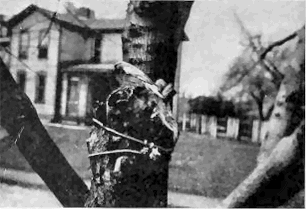
GOING HOME
Photographed by W. R. Boulton, Jr.
Both parents were often seen cleaning the nest. They began to feed the young at about eight o’clock every morning, and continued it steadily at an average of every six or seven minutes until about six at night, using as food almost exclusively a certain kind of bug that was very hairy, brownish with black markings, and, except for the hair, might have been mistaken for castor beans, being about the same size. They seemed a huge mouthful for a young Bluebird. Several times a day I would climb up to the nest and whistle softly like a Bluebird before the aperture. The young would crane their necks and stretch their mouths for the supposed food, although none was forthcoming.
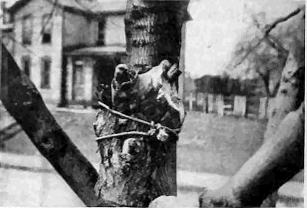
LEAVING HOME
Photographed by W. R. Boulton, Jr.
When the young flew from the nest, I felt as though I had lost a family. My grief was not such that I could not capture them, however, and after counting noses, I found that one was missing. I climbed up and there I found ‘runtie’ at the bottom of the nest, pitifully squeaking at being left alone. I took out the bottom and extracted him. Finally, after half an hour or more of posing, I got several good pictures of the babies on a dead branch. When I opened the nest-log to clean it, I found a little block of grasses about three inches in diameter and one inch high. It fairly glistened with shed feather-sheaths. In the bottom were six or seven bugs, of the species [125] mentioned before, that had evidently escaped the birds. Exactly two months after the first egg was laid, the second nest of the same pair was nearing completion in another of my boxes. Here are the dates.
While the female was incubating, the male still fed the young of the first brood, although not so often as when they left the nest.—Wolfrid Rudyerd Boulton, Jr. (Age 14 years), Beaver, Pa.
[Perhaps no better word of appreciation of this carefully worded description of personal observations could be given than to quote from a letter written by Mr. Herbert K. Job with reference to the data given by Master Boulton, Jr.: “His accurate information about the periods of incubation and rearing of the Bluebird came in handy to me just now, as there is a pair in a box up-state which I want to ‘film’ at just the right period, and now I can estimate when to make the trip.” The pictures illustrating this article were not only taken, but also developed and finished by the observer.—A. H. W.]
A MUSICAL WOODLAND
Riding on my pony in a thick-set wood, I heard the “Feathered Musicians” playing on their instruments.
First the trill of the Wood Thrush, then the sweet trill of the Meadowlark, the rapidly repeated ‘wickci’ of the Flicker, the sweet melody of the Robin, the charming song of the Song Sparrow, and the ‘chip’ of the Chipping Sparrow, were most delightful.
Far off in the distance I could hear the sweet Canary-like whistle of the Goldfinch and the ‘eak’ of the Purple Grackle.
The woods rang with the music of the birds, for nothing is so sweet as natural music.—Sarah W. Weaver (Age 11 years), Baltimore County, Md.
[“For nothing is so sweet as natural music.”
This naive observation brings to mind the gurgle of brooks, waving treetops, and hum of busy insects, as well as the music of feathered songsters. It has the essence of spring in it, when awakening life so quickly voices itself in melody.—A. H. W.]
INTERESTING PERFORMANCE OF A TUFTED TITMOUSE
While taking refuge from a slight April shower on the porch of an unoccupied summer cottage at Lithia Springs, Ga., twenty miles from Atlanta, I once witnessed an interesting performance by a Tufted Titmouse. Having chosen a damp brown oak leaf from the ground, it flew with it into a bare tree, and, holding the leaf with its claw firmly against a branch, it drew itself to its full height, raised its head like a Woodpecker, and with all the might of its tiny frame gave, a forcible blow to the leaf with its bill. This process was kept up nearly half an hour. The bird seemed utterly indifferent to the near presence [126] of my two friends and myself. Once it dropped the leaf, but immediately picked it up and carried it back to the tree. A boy passed on the sidewalk below. The bird flew to a higher branch. At last its purpose seemed to be accomplished. It rested, and lifted the leaf by the petiole. We then saw that the hammering had made it into a firm brown ball nearly as large as an oak gall. The bird flew with it behind the kitchen-ell of the cottage. We hurried around, and were met by the Titmouse, empty-billed, who looked at us with an innocent, nonchalant air. Had it dropped the ball into its nest-hole?—Lucy H. Upton.
[Who can add any information which will throw light on this unusual observation?—A. H. W.]
TWILIGHT HOUR AT ASHAWAY
—Ruth R. Hayden.
[This poem was written by a student in The Rhode Island State Normal School. It is of unusual interest since the author, although blind, undertook the course in nature-study and succeeded so well that her instructor writes: “I am tempted to say that only those are blind who won’t see. I am convinced that the subject is most valuable for classes in schools of the blind.” See Bird-Lore, Vol. XIII, No. 6, p. 316.—A. H. W.]
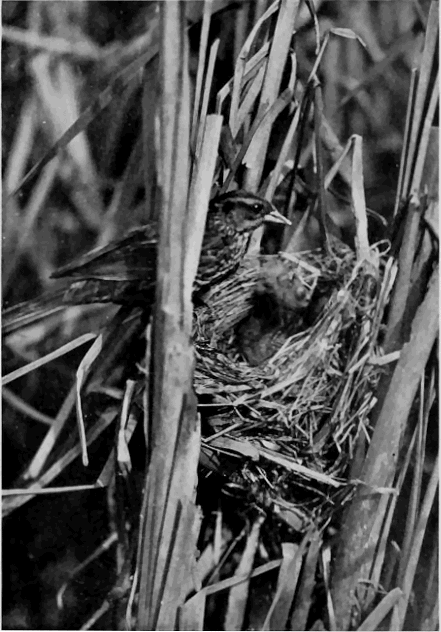 FEMALE RED-WINGED BLACKBIRD, NEST AND YOUNG
FEMALE RED-WINGED BLACKBIRD, NEST AND YOUNGTHE CHESTNUT-SIDED WARBLER
By T. GILBERT PEARSON
EDUCATIONAL LEAFLET NO. 85
Among the most charming birds in the world are the members of that group classified as the family of Wood Warblers. There are about one hundred and fifty-five known species, and they are found in no other country but America. Seventy-four kinds occur in North America, and fifty-five of these have been recorded in the United States.
They are small birds, the majority measuring rather less than five and one-half inches from bill-tip to tail-tip. They are birds mainly of woods and thickets, a few only venturing into open country. The Warbler’s bill is longer than that of most small birds, and is well adapted for seizing the soft-bodied insects upon which it so largely preys.
One of the most common members of the family in the Eastern States is the Chestnut-sided Warbler. The general appearance of the male is that of a particularly trim little bird with olive-green back and bright yellow crown; the under parts are lighter, and the sides are marked by deep chestnut—that is, this is the way the male looks in spring. At this season the female is quite similar, although its colors are duller. In the fall and winter the plumage presents a very different appearance. The upper parts then are yellowish olive-green, sometimes with faint streaks on the back. The deep-chestnut of the sides has given way to a few spots or patches of this color.
In seeking the Chestnut-sided Warbler, one should go to woodlands that have been cut over and grown up in bushes. There are found the conditions which this bird dearly loves, and in such a situation one may pass a whole forenoon and seldom be out of sight or hearing of one or more of them.
The nest is made of strips of bark, soft dead leaf-stems, and similar material; it is lined with tendrils and rootlets. Usually the nest is from two and a half to three and a half feet from the ground. Rarely have I found one so situated that it could not readily be reached by the spring of an agile house-cat, and there is much evidence to show that many are pulled down every year by these feline hunters.
It is commonly reported that as many as five eggs are deposited in the nest before the bird begins sitting, but fully three-fourths of those nests that I have found contained only four eggs. They are white, with numerous brown markings of various shades—some distinct, others more or less obscure, as if the inside of the shell had been painted and the color was showing through. The spots and blotches are gathered chiefly in a wreath about the larger end.
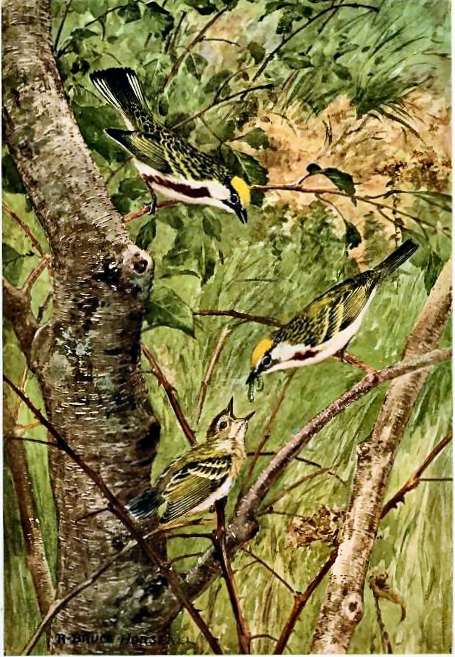
CHESTNUT-SIDED WARBLER
National Association of Audubon Societies
They are pretty, dainty little objects, as is the case with all Warblers’ eggs. In size, they are about two-thirds of an inch long, and half an inch in diameter at the largest place.
In the latitude of Boston, fresh eggs may usually be found late in May or in the first week of June.
The Chestnut-sided Warbler feeds almost exclusively on insects. John James Audubon wrote that once in Pennsylvania, during a snowstorm in early spring, he examined the dead bodies of several, and found that their stomachs contained only grass-seeds and a few spiders. The birds were very poor, and evidently were in a half-starved condition, which would probably account for the fact that they had been engaged in such an un-warbler-like act as eating seeds. Ordinarily this bird is highly insectivorous, and feeds very largely on leaf-eating caterpillars. It also collects plant-lice, ants, leaf-hoppers, small bark-beetles, and, in fact, is a perfect scourge to the small insect-life inhabiting the foliage of the bushes and trees where it makes its home. Sometimes the birds take short flights in the air after winged insects. It will thus be seen that the Chestnut-sided Warbler is of decided value as a guardian of trees, which is reason enough why the legislators of the various states where the bird is found were induced to enact the Audubon Law for its protection.
All birds that depend so much on insects for their livelihood as does the Chestnut-sided Warbler are necessarily highly migratory. By the middle of September nearly all have departed from their summer home, which, we may say roughly, covers the territory of the southern Canadian Provinces from Saskatchewan eastward, and extends southward as far as Ohio and New Jersey. They are also found in summer along the Alleghany Mountains in Tennessee and South Carolina. Most of the migrants go to Central America by way of the Gulf of Mexico, and only a comparatively small number travel to Florida and the Bahama Islands.
The song of the Chestnut-sided Warbler is confused in the minds of some listeners with that of the Yellow Warbler. Mathews says the song resembles the words, “I wish, I wish, I wish to see Miss Beecher.”
Mr. Clinton G. Abbott, writing in Bird-Lore in 1909, told most entertainingly of the fortunes of a pair of these Warblers and their nest, which he watched one summer. After telling of finding a nest from which all the eggs had been thrown but one, and in their place had been deposited two eggs of the Cowbird, he says:
“The nest was found at Rhinebeck, New York, on July 6, 1900, incubation having apparently just started. Four days later I discovered that one of the Cowbird’s eggs was infertile; so I removed it from the nest, disappointed that I should not, after all, enjoy the somewhat unique experience of observing two young Cowbirds growing up in the same nest. It was some time during the night of July 13-14 that the first of the remaining two eggs hatched—the Cowbird’s of course. The Warbler’s hatched between twelve and twelve-thirty[130] o’clock on the 14th. The nicety with which matters had been so arranged that the young Cowbird would have just a convenient start in life over its unfortunate rival commanded at least my admiration if not my sympathy. Cowbirds must indeed be sharp nest-finders to be able to discover at short notice not only the nests of certain suitable kinds of birds, but even nests containing eggs at a certain stage of incubation!
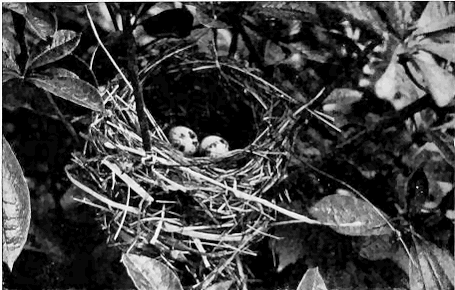
A NEST OF THE CHESTNUT-SIDED WARBLER
“After the hatching of the eggs, I spent considerable time at the nest-side, and observed with interest the many pretty little incidents of a bird’s domestic life—the constant and tender brooding of the newly hatched young by both Warblers in turn; the never-ceasing search among the neighboring trees and bushes for small caterpillars; the delivery of the food by the male to the brooding female, who, in turn, would raise herself and pass it to the young; the careful cleansing of the nest; and many other intimate details of the birds’ loving and happy lives. When I drew aside the leaves that sheltered the nest and allowed the sun to shine upon it for purposes of photography, the mother, realizing with that wonderful instinct common to all birds which nest in the shade, the fatal effect on her babies of the sun’s direct rays, would take her stand on the edge of the nest and with outstretched wings would form of her own body a living shield for the comfort and protection of her young. Although herself in evident distress from the heat, and with parted mandibles continually gasping for air, she would remain in this position as long as the sun shone upon her, only stepping aside occasionally when a well-known signal announced that her husband had arrived with a meal for the little ones. It was a beautiful picture of parental devotion.
“As the young birds began to grow, the Cowbird not only maintained, but rapidly increased its lead over its small nest-mate. At every visit of the parent bird with food, its capacious gullet could be seen violently waving aloft and almost completely hiding the feeble little mouth of the Warbler, whose owner was pathetically doing its best in a dumb appeal for food. The Cowbird’s appetite seemed never to be satiated and, unlike most nestlings, which relapse after a meal and give their brethren the next chance, he seemed ready for every fresh opportunity; and, by reason of his superior display, he usually succeeded in obtaining the coveted morsel. However, the young Warbler did manage to get an occasional portion, and I had strong hopes that he might reach maturity. For I realized that a Chestnut-sided Warbler’s usual laying is about five eggs, and that therefore some four eggs must have been made to give place to the two Cowbird’s. Hence the young Cowbird in the nest might reasonably be granted the room and food of four young Warblers. More than this I hoped he was not getting.
“On July 18, at 3.30 P. M., when the birds were about four days old, I took them from the nest to compare their sizes. I replaced them in the nest, but that was the last I saw of the poor little Warbler. When I returned at 5 P. M., the Cowbird was in sole and triumphant possession of the nest. Just what became of the Chestnut-sided Warbler will never be known, but my theory is that, weakened by lack of sufficient food, the little fellow at last became too feeble to raise himself at all, and was crushed to death by the Cowbird’s gross body. The parent birds, returning and finding the little corpse in the bottom of the nest, were no doubt impelled by their instinctive sense of cleanliness to carry it to a distance; for the most careful search over a large area beneath the nest failed to reveal any sign of the missing bird, thus proving that it had not fallen from the nest nor been forced out by the Cowbird.
“The Cowbird now had things all his own way and, there being no one to dispute his right to all the food, he grew with amazing rapidity. The dainty little cup of a nest, never built to accommodate such a monster, was soon completely forced out of shape. His body then protruded beyond the lower rim of the nest, and the ground underneath became littered with droppings, quite baffling the cleanly, sanitary instincts of the Warblers.
“The Cowbird, now almost twice as large as his devoted foster-parents, rises with hideous chitterings of delight to receive an ever-acceptable meal. I visited the nest at 7.30 A. M., on July 26. As I walked home to breakfast, I resolved that in the interests of justice I ought to put an end to that Cowbird, as a murderer and a menace to the welfare of birddom. But when I returned to the spot, about 9 A. M., he had escaped me; the nest was empty, my bird flown. No doubt, if I had searched and listened, I should have heard him shouting for food not far away; but my spirit of vengeance was only half-hearted at best, and so I left him, a criminal abroad, to be the parent, I suppose, of others as bad.”
EXECUTIVE DEPARTMENT
Edited by T. GILBERT PEARSON, Secretary
Address all correspondence, and send all remittances for dues and contributions, to
the National Association of Audubon Societies, 1974 Broadway, New York City.
William Dutcher, President
Samuel T. Carter, Jr., Attorney
Any person, club, school or company in sympathy with the objects of this Association may become a member of it, and all are welcome.
Classes of Membership in the National Association of Audubon Societies for the Protection of Wild Birds and Animals:
| $5 | annually pays for a Sustaining Membership |
| $100 | paid at one time constitutes a Life Membership |
| $1,000 | constitutes a person a Patron |
| $5,000 | constitutes a person a Founder |
| $25,000 | constitutes a person a Benefactor |
Form of Bequest:—I do hereby give and bequeath to The National Association of Audubon Societies for the Protection of Wild Birds and Animals (Incorporated), of the City of New York.
In the last issue of Bird-Lore were reproduced some photographs of a ruined White Ibis rookery, which Dr. Herbert R. Mills stated had been destroyed by “sportsmen” who had wantonly shot the birds. Such raids on the bird-life of Florida have been made frequently by northern visitors to the state. A striking example of this habit has just come to public notice.
In the February issue of Scribner’s Magazine, a writer, after referring to the pleasures he enjoyed while catching tarpon at Bocagrande, says:
“Birds were always flying around the boat; Gulls, Man-o’-wars, Pelicans, and when we weren’t fishing we were potting at them with a Winchester .22. The Big Chief was a wizard with a rifle, and even skimming Swallows were none too swift or too small for his Deadeye Dick precision of aim. After cutting down a sailing Man-o’-war, two hundred yards above the water, and surely three hundred yards away, he formed a Man-o’-war’s Club; any body who killed one flying was entitled to membership.”
All these birds are protected by the laws of Florida and at least one of them by the United States Migratory Bird Law. There is no open season for any of them. The man who wrote this is not a poor, illiterate inhabitant of the southern swamps, who killed the birds to sell their feathers for a few dollars with which to help feed his family; but is a successful writer of novels and stories, many of which you and I have bought and read with pleasure. Incidentally, by our purchase of his work, we have aided in swelling his royalties, thus enabling him to go to Bocagrande, and doubtless elsewhere, where he might amuse himself from time to time in the very delectable sport of shooting harmless non-game birds. This man is John Fox, Jr.
As a result of the work of this Association, the Pelican colonies in Charlotte Harbor near Bocagrande have been made Federal bird-reservations. While attempting to protect one of them, Columbus G. McLeod, one of our wardens, had his head chopped open and his body sunk in the harbor by persons who did not approve of his zeal. These birds—the wards of the Government, the birds that the Audubon Society’s members have been giving money to protect, and the birds for which one good man has given up his life—these birds afford targets for Mr. John Fox Jr., and his friends; and [133] Scribner’s Magazine, doubtless greatly pleased at the privilege of being allowed to publish an article from the pen of a gentleman so distinguished, kind and altruistic, has taken these boasting sentences and printed them, regardless of the fact that the magazine will go into thousands of homes to be read by young men who may later go tarpon-fishing in the limpid waters about Bocagrande, and who might be inspired to follow the example of the noble deeds of this celebrated novelist.
We are glad to reproduce here an open letter written to him by Doctor William F. Blackman, President of the Florida State Audubon Society:
“Dear Sir: As a tarpon fisherman, holding the record in a recent year for the largest fish taken in the state, I was much interested in your article in the February Issue of Scribner’s Magazine, on ‘Tarpon Fishing at Bocagrande.’ But when you told your readers that you and your companions beguiled your leisure, on this occasion, by ‘potting with a Winchester .22’ at the Gulls, Man-o’-wars, Pelicans, and skimming Swallows which surrounded your boat, you surprised and pained and disgusted me beyond words.
“You doubtless knew that all these birds are protected by the laws of Florida, and some of them by the Federal laws also; your action was deliberately criminal; it was also unspeakably puerile, wanton, cruel, and vulgar.
“The citizens of Florida welcome tourists from other states; we are happy to share our excellent fishing and shooting with them within legal and decent limits, which, I am glad to say, the great majority of those who sojourn among us carefully and cheerfully observe; but we do not propose to allow our plumage and insectivorous birds to be slaughtered to provide fun for thoughtless and reckless gunners whether residents or visitors.
“You are too foxy to say whether you yourself succeeded in killing any of these birds, but I hereby give you notice that if you ever again set foot on our soil, and I am apprised of the fact, I shall see that you have an opportunity to tell your story in the courts. If proof can be had of your personal guilt, you will be punished to the full limit of the law, in both the state and federal jurisdictions, for a misdemeanor so unsportmanlike and inexcusable.”
To watch at close range the wildfowl accumulated on the Ward-McIlhenny reservation in the marshes of Louisiana is the privilege of a lifetime.
Mr. Herbert K. Job not only had this privilege for about six weeks during last December and the early weeks of January, but he procured a remarkable series of photographs of water-birds that make that region their winter home. From the moving pictures that he made the Association now has a thousand-foot reel, showing Pintails, Teals, and other Ducks, as well as Boat-tailed Grackles and Coots.
To ornithologists, the most interesting pictures he obtained were those of the Blue Geese. The chief summer home of these birds is supposed to be on the islands north of the American continent, and most, if not all of them, pass the winter in the marshes of Louisiana. I know of no case heretofore where they have been photographed in large numbers at close range.
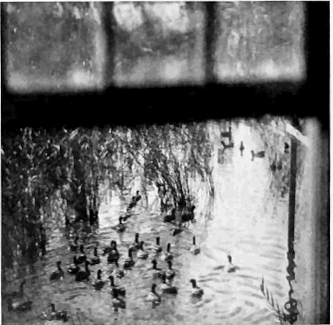
PHOTOGRAPHED FROM THE WINDOW OF A CABIN ON THE WARD-McILHENNY RESERVATION
The accompanying illustrations were all made by Mr. Job on this expedition, and will give some idea of the results of his skill and patience in the use of a moving-picture camera.
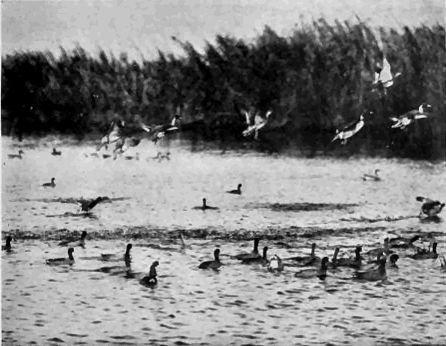
WHEN ALARMED, THE DUCKS WERE THE FIRST TO TAKE FLIGHT
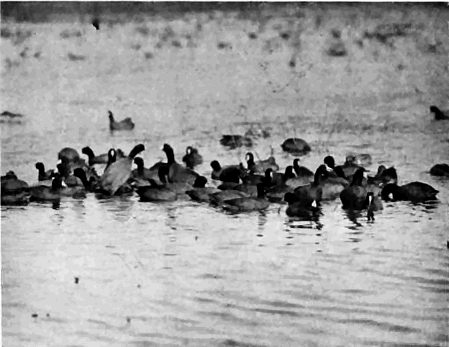
AN INTERESTING COMPANY OF COOTS

PINTAILS, TEALS, AND COOTS, PHOTOGRAPHED FROM CABIN WINDOW
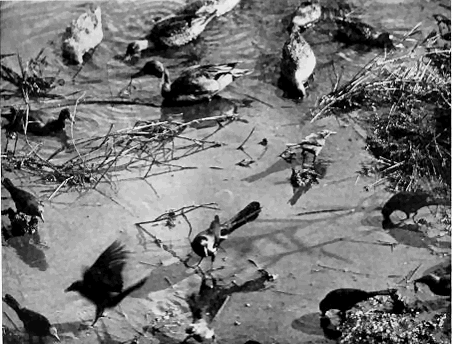
PINTAILS, TEALS, AND BOAT-TAILED GRACKLES, PHOTOGRAPHED FROM CABIN WINDOW
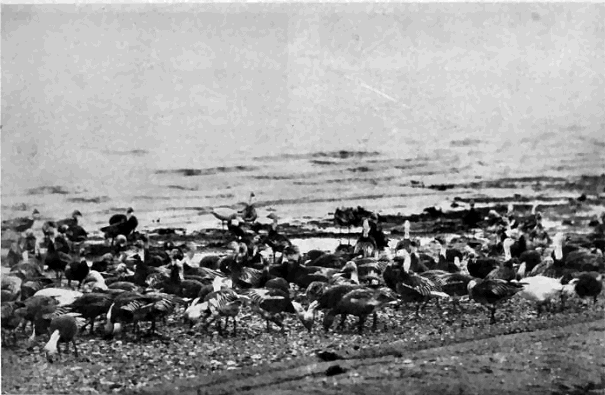
BLUE GEESE AND A FEW GREATER SNOW-GEESE "GRAVELING" AT VERMILION BAY, LOUISIANA.
MR. JOB WAITED FIVE DAYS IN A BLIND TO GET THESE PICTURES OF GEESE
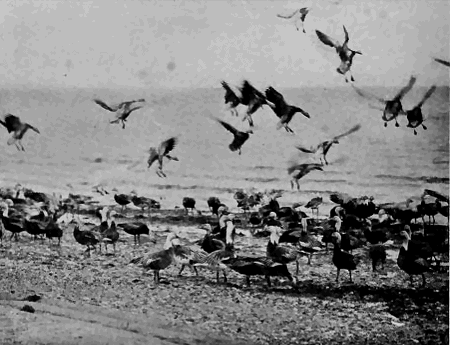
BLUE GEESE AND SNOW-GEESE ALIGHTING. VERMILION BAY, LOUISIANA, JANUARY 3, 1916
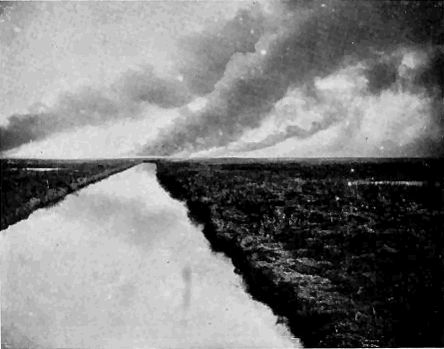
THE MARSH ON FIRE
On the morning of February 5, 1916, there was received at the office of the National Association the following telegram:
“The State Game Warden, Topeka, Kansas, reports his state covered with three to nine inches of sleet and ice. Birds starving by wholesale. State organizing campaign for food. Can you assist? Immediate action necessary. E. W. Nelson, Acting Chief, Biological Survey.”
We immediately telegraphed to the State Game Warden of Kansas offering $200 for the purchase of grain. Shortly afterward the following telegram was received from Honorable Carlos Avery, State Game Commissioner of Minnesota:
“Conditions critical for Quail on account of unprecedented depth of snow and extreme cold. Funds insufficient to care for them adequately. Can you include Minnesota for appropriation for this purpose?”
This second call for help, together with word received from other directions, indicated that the snow and ice-cap had extended generally over a number of the northern states of the Middle West. We at once wired to the officials of some of the organizations in several of these states, and also sent telegrams to thirty-five members of the Association, telling them of the situation and asking for contributions to be used in the purchase and distribution of food for the birds. Many of the members immediately responded, and in a remarkably short time we had collected and telegraphed to the Cleveland Bird-Lovers’ Association $200, to the President of the South Dakota State College $200, and to the Minnesota Game Commission $600.
We also telegraphed the Postmaster General in Washington asking that rural mail-carriers in Minnesota, Kansas, and Nebraska be authorized to distribute grain to be supplied them for the purpose. The Third Assistant Postmaster General at once gave the instructions requested.
Mrs. Elizabeth C. T. Miller, President of the Cleveland Bird-Lovers’ Association, sent notices to all on her large membership list, called upon the people generally through the press, and set other movements in operation looking to the good of the birds.
The South Dakota State College is the largest educational institution in the State, enrolling over eleven hundred members. President E. C. Perisho, who is a lover of wild birds and, incidentally, one of the most influential and public-spirited educators of the West, called a mass meeting of his students and laid the situation before them. The following is from one of his letters, and will give some idea of what resulted.
“We are doing everything possible at this end to save the birds of South Dakota. I thought perhaps you would be interested to know that our organization for this purpose is as follows:
“1. The State College has written to four hundred or five hundred boys and girls, members of the Boys’ and Girls’ Clubs of the state, asking them to scatter grain and make some protection to save the Field Sparrows, Quails, and Prairie Chickens especially.
“2. The entire extension force of the College, including all the short-course demonstrators, district men, etc., have been written to and are coöperating with us.
“3. All the county agents of the state are interesting the school children of their counties, and a number of farmers and the rural mail carriers.
“4. The commercial clubs in all the large towns of the state, and the smaller ones where grain is most needed, have been written to, asking for their immediate coöperation.
“5. All the state institutions, five besides our own, have been asked to help in this matter.
“6. A number of high schools and township schools, etc., have been asked to help.
“7. Between one and two hundred farmers, well distributed over the state have had personal letters.
“Money in small amounts has been promised to county agents, commercial clubs, etc. I met a number of the young men of our college today and talked to them about the situation, and asked for their coöperation in writing to their homes, etc. Those most interested in the work went out, after the meeting, and had a picture taken. I will send you this photograph as soon as it is developed.”
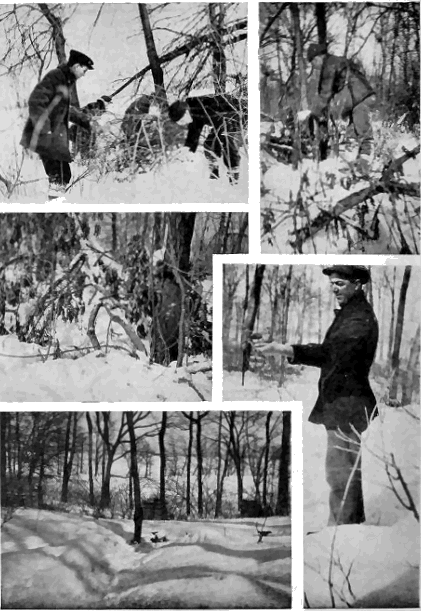
SAVING THE QUAIL IN MINNESOTA
1. Locating nesting-places of Quails under brush and broken treetops. 2. Placing grain under brush just occupied by a bunch of Quails. 3. Fifteen Quails were found here on February 13; food was left for them. 4. Some Quails become weak from lack of food, are easily caught, and sit contentedly in one's warm hand. 5. Several Quails near the foot of a tree, and one (at the right) running.
In Minnesota, the “Save the Quail Association” was immediately formed by the sportsmen of St. Paul and vicinity. Mr. Carlos Avery put the State Game Wardens to work, and the matter was given wide publicity. An immense work was done throughout the state in the way of feeding birds. Mr. Avery has sent in a large number of photographs, showing the men actually at work for the relief of the birds. The method of feeding the Quails, to locate the covies, scrape the snow away, and put out food.
The heavy snow and extreme cold prevailed over a large area of the northern United States, and more work was probably done to feed the birds this winter than ever before under similar conditions. Many of the State Game Commissions have funds for this purpose, and have been very active.
Quails and Pheasants are known to have suffered much in Oregon and Washington. A quaint little incident is reported of pheasants in Washington, sent us by a correspondent in British Columbia. He relates that the Pheasants during the time of deep snow not only came familiarly about barnyards, but were fond of perching on the backs of the hogs in order, apparently, to warm their chilled feet.
There have been some losses in New England, and even from New Jersey reports reached the office of the toll of bird-life that the heavy snow had taken.
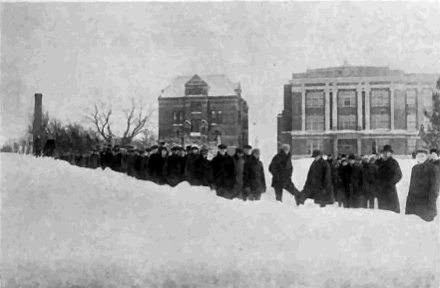
STUDENTS OF THE SOUTH DAKOTA STATE COLLEGE, AFTER LISTENING TO AN ADDRESS BY PRESIDENT E. C. PERISHO, ON THE NEED OF FEEDING BIRDS IN WINTER. NOTE THE DEPTH OF THE SNOW.
When George Bird Grinnell coined the term “Audubon Society,” and started the Audubon Movement, in 1886, one of the first to respond to the call and to go actively into the work was Miss Florence Merriam, who, with Miss Fanny Hardy—now Mrs. Eckstorm, author of several bird-books—in March, 1886, organized the Smith College Audubon Society. Soon afterward Miss Merriam assumed the duties of a local Audubon secretaryship, in northern New York, and also secured local secretaries in several neighboring towns.
In 1897, when the Audubon Society of the District of Columbia was organized, she was one of its chartered members. For many years, as Mrs. Florence Merriam Bailey, she has been an active member of its executive committee, and, among other duties, has had charge of the annual spring bird-class, one of the most important features of that Society. That her interest in the work is deep, and sympathetic to an unusual degree may be shown by a quotation from a letter that she wrote to the California Audubon Society on the occasion of its organization:
“Wherever you go, study the birds and tell your friends of them. Point out to them the chaste beauty of your exquisitely tinted waterfowl; let them see the glowing splendor of your Tanagers, the flashing jewels of your Hummingbirds. Take them to the fields, that they may listen in rapture to the rare voice of your Meadowlark; take them to the deep canyons filled with the flute-like notes of the Canyon Wren; and to the fir forests on the mountainsides, where their souls will be stirred by the uplifted song of the Thrush.
“By knowing the birds personally, you will bring to your Audubon work the enkindling spark of enthusiastic friendship. In all phases of your work, for yourselves, your friends, your birds, and your children, you have my hearty interest and good wishes. For fifteen years I have been waiting for you to take up the cause of the California birds, and for many years I have been working with the children of the West on my heart. Knowing this, you may well believe that I wish your beautiful work an earnest God-speed.”
Mrs. Bailey’s natural girlhood’s interest in wild birds was greatly quickened by dwelling in a home in which scholarship and a love of scientific accuracy were taught daily; and she had the added advantage of living in a region of northern New York well supplied with bird-life. In a recent letter she wrote: “Having been brought up on Coues’s ‘Key,’ and trained by my brother, Dr. C. Hart Merriam, on leaving College in 1886 I began doing careful field-work.” Since that day, no woman has studied the wild birds of America so systematically, so thoroughly, and so carefully as she. The amount of field-work she has done is perfectly astonishing, and probably few women have spent so many days in the wilds, or so many nights under canvas, as has Mrs. Florence Merriam Bailey. Her work, partly conducted in company with her brother, Dr. Merriam, and her husband, Mr. Vernon Bailey, has been carried on not only in eastern and southern states and in the Bermudas, but also in Arizona, Oregon, California, North Dakota, Texas, Utah, and New Mexico.
As a teacher of others, she has given bird-talks and conducted field-classes in bird-study in various parts of the country, and for thirty years her name has been before the public as a writer of popular and scientific articles. The titles of no less than seventy communications published in The Auk, Bird-Lore, The Condor, Forest and Stream, The Outlook, Popular Science, The American Agriculturist, and elsewhere, have come to my attention. Her first book, “Birds Through An Opera Glass,” was published in 1889. This was followed by “My Summer in a Mormon Village,” 1895; “A-Birding on a Bronco,” 1896; and “Birds of Village and Field,” 1898.
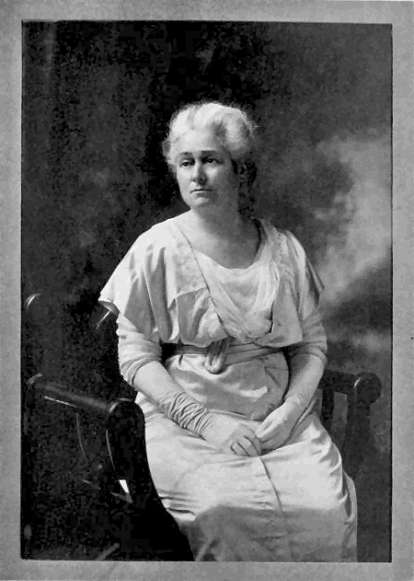
FLORENCE MERRIAM BAILEY
Her largest and most valuable contribution to the literature of ornithology is her “Handbook of Birds of the Western United States,” first published in 1902. From the day of its appearance, this was hailed as the most practical and useful book on our western birds that had ever been published, and for many years to come it will be regarded as the standard work on the subject. No serious student of bird-life in the western United States would think of being without this valuable book on his study-table.
Enrolled from January 1 to March 1, 1916.
Life Members. |
Stillman, B. G. Sustaining Members. |
Gale, C. C.[145] |
Morton, Mrs. Levi P. |
|
Townsend, Eugene L.
[146] New Contributors. Contributors to Egret Fund
|
|
|
|
By a vote of twenty-four to nine, the Senate of the Virginia Legislature has passed the bill of the Farmers’ Union and the Audubon Society for the establishment of a Commission of Fisheries and Game. The bill was signed by the Governor on March 13, 1916. Thus ends a fight which the Audubon Society has led in the Virginia Legislature, session after session, for many years.
Mr. M. D. Hart, President of the Virginia Audubon Society, and others who have labored hard for the successful passage of this measure, are to be congratulated. Now, at least, we may hope for some good bird-and-game protection in that state, for the commissioner will have power to employ wardens, and will have funds with which to pay them.
The methods of selecting the local wardens is rather unusual: From a list of ten names, submitted by the boards of supervisors of the counties and the councils of cities, the commissioner will select wardens—one for each county and city in the commonwealth. In communities of less than 20,000 inhabitants these officers will be paid a salary not to exceed $50 a month. In more populous communities their monthly pay will not be in excess of $60. Special wardens may be appointed to serve for not more than $3 a day. The commissioner or any of his wardens may serve original processes as sheriffs and constables. Every hunter who leaves his own premises or those adjoining his will be required to obtain from the commissioner a hunter’s license. Residents will be charged $1 for the privilege of hunting in their county, and $3 for a state range. Non-residents may hunt anywhere in Virginia on payment of $10.
The victory in Virginia leaves only two states in the Union that have no game-warden system. These states are Florida and Mississippi, which still vie with each other for the honor of being the Rip Van Winkle state in the matter of bird-protection.

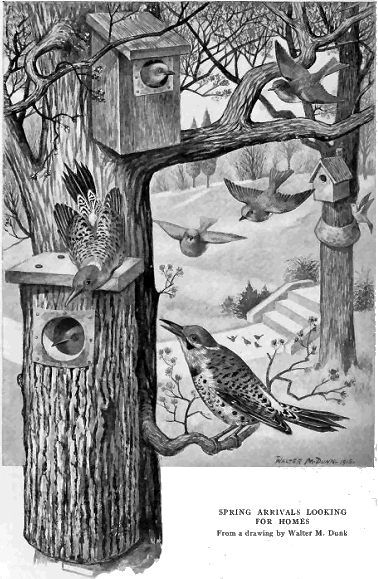 SPRING ARRIVALS LOOKING FOR HOMES
SPRING ARRIVALS LOOKING FOR HOMESNOTES FROM THE FIELD
Birds Beautifying Cemeteries
Some time ago, the Secretary happened to visit a suburban cemetery, where landscape-gardening and sculptural art had done what they could to make the scene beautiful and comforting, but he was impressed by the absence of singing birds. Alien Sparrows were chattering, and the gurgling of a Grackle was heard in the distance, but none of the sweet voices and pretty forms of the native birds charmed the ear or gladdened the eye of a visitor. This seemed strange, for the varied trees and shrubbery, with sunny spaces among them, quiet and guarded against noisy intrusion, would be exceedingly attractive and favorable to bird-life; and it occurred to him that in no place would an invitation to the birds to make themselves at home in summer be so likely to be accepted; nor could anything be more appropriate than their cheerful presence. They will prove useful, too.
These thoughts induced him to write a brief essay, entitled “Cemeteries as Bird-Sanctuaries,” which has been published by the National Association as Circular No. 2, and distributed to many persons likely to be interested. The response has been most encouraging. Associations and individuals all over the country have written for this circular, and are taking measures to furnish cemeteries with shelters, nesting-boxes and feeding-stations for birds under instruction from the Association. The great Forest Lawn Cemetery near Omaha, for example, is putting up 100 nest-boxes as a beginning. The Rosehill Cemetery and others about Chicago are undertaking similar enterprises, and the Cemetery Beautifying Association of San Francisco is planning this addition to its methods of making more attractive the resting-place of the dead. Blue Bird announces that the Lake View Cemetery at Cleveland, Ohio, will erect many feeding-tables and nest-boxes, in its grounds. The matter has been taken up by the Lexington Kentucky Audubon Society. Other instances might be mentioned.
It is greatly to be hoped that many others will follow their example. The movement we think is worth while, for the sake of humanity as well as for the birds.
The Oregon Audubon Society
The Oregon Audubon Society has recently established headquarters in the Young Men’s Christian Association building, in Portland. The room occupied by the Society has been tastefully decorated with pictures, and contains cabinets of specimens for study. It is planned to give lectures regularly on Saturday evenings.
Mr. William L. Finley, President of the Society, and the Pacific Coast field-agent for the National Association, in company with Mrs. Finley, has this spring been spending several weeks in the East, where he has been constantly engaged in giving lectures illustrated with moving pictures of sea-birds, Sage Grouse, sea-lions, cougars, black bears, antelopes, and other interesting forms of western wild life.
Work Along Columbia River
The Federation of Women’s Clubs in the State of Washington has been notable among such organizations for that practical interest in bird-life which arises from an appreciation of their usefulness as well as their beauty. It has recently testified to this most substantially by becoming a member of this Association. Last year, and to a less extent in the previous year, the Federation was represented largely at the State Fair by an exhibition that was called the “Bird Court,” in which all sorts of ornithological things were displayed to great advantage. The success of these exhibitions was due largely to the wisdom and energy of Mrs. G. R. Pike, of North Yakima, who has been indefatigable in her efforts to spread the study of birds in the schools. She has been traveling and [150] lecturing throughout the state for some time, under the auspices of the State Federation, which has supported this agency generously. The National Association has coöperated in all these matters, and feels that it is abundantly rewarded by results. It has now enabled Mrs. Pike to extend her work, and it anticipates still larger results in the organization of Junior Classes, and in the stimulation of a general interest in the cause throughout the Columbia Valley.
Feather Importation In Canada
It may not be generally known to the readers of Bird-Lore that, immediately following the passage of the Tariff Act in Washington, on October 3, 1913, which prohibited the importation of feathers to this country, the Canadian Parliament, largely through the efforts of Dr. C. Gordon Hewitt, passed a somewhat similar measure. The Canadian law prohibits the importation of:
“Aigrettes, Egret plumes, or so-called Osprey plumes, and the feathers, quills, heads, wings, tails, skins, or parts of skins, of wild birds, either raw or manufactured; but this provision shall not come into effect until January 1, 1915, and shall not apply to the feathers or plumes of Ostriches; the plumage of the English Pheasant and the Indian Peacock; the plumage of wild birds ordinarily used as articles of diet; the plumage of birds imported alive, nor to specimens imported under regulations of the Minister of Customs for any natural-history or other museum, or for educational purposes.”
Allan Brooks a Soldier
Allan Brooks, the artist, many of whose colored pictures of birds have appeared in Bird-Lore, is with the English Army “somewhere in France.” In the summer of 1915 he wrote the office that he would not be able to do further work for the Association for some time, as he was going to Europe to study. Almost immediately after his arrival in England war broke out. He at once returned to Canada and enlisted in a company at his home in British Columbia. He has been promoted from the rank of Lieutenant to that of Captain. Last December, when Captain Brooks had attained the distinction of the longest continuous trench service of any officer of the Canadian army, he was offered a more restful position behind the lines, but he declined it.
In a letter received by one of his friends a short time ago he stated that he had thus far escaped injury with the exception of deafness in one ear, as a result of a shell-explosion; and that, if he survived the war, he would return to America and hoped to paint better pictures than before.
Deer-Killing Dogs
A lady writes from a village in northern New York of the evil of loose dogs in rural communities; and of her care for winter-birds:
“On Sunday morning, January 23, two dogs chased a deer (a young doe), that strayed down from the mountains, and attacked it most viciously until it sank exhausted and wounded on the grounds of the summer home of the church of the Heavenly Rest, of which my husband is gardener and caretaker. He and my son rescued the deer from the dogs, and a neighbor notified the supervisor, who gave permission for its removal to a barn, awaiting the arrival of the game warden. My three children are members of the Audubon Society, and are greatly interested in all wild things. They are heart-broken about the deer, and we try to protect everything wild that comes our way. We have many wild birds around our house, which we coaxed around by putting little houses in the branches of nearby trees, and putting crumbs and scraps in them. We also fixed some branches of hemlock on the windowsill of our dining-room, on which my husband ties pieces of suet, doughnut, bones, and pieces of a pudding I make especially for them, of suet, currants, raisins, bread-crumbs, and scraps of meat; and oh, how they enjoy it!”—Mrs. John W. Payne.
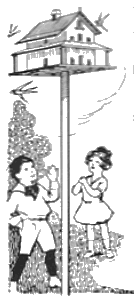
The Kind That Win Birds
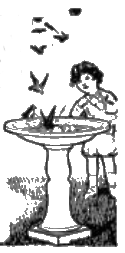
|
Dodson Bird Houses Don’t delay. Birds will soon be here. Put out Dodson Bird Houses now and have Bluebirds, Wrens, Martins, Flickers, etc. living in your garden. Buy houses made by a bird-lover. Mr. Dodson has loved and worked for Native Birds all his life. Dodson Bird Houses (20 styles—for all kinds of birds) used by birds in every state. Martin House (illustrated here), $12; Wren House $5; Bluebird House, $5; Flicker House, $2.50 to $5; Chickadee House, $1.50 and $2.50; Bird Baths, $6 to $17. Prices f.o.b. Kankakee, Illinois. |
|
FREE PICTURE Of bird in Natural
Colors, with descriptive folder of Nature
Neighbors, the best set of books about
birds published. Write for this—now.
FREE BOOKLET Telling How to Win
Native Birds, and illustrating the famous
Dodson Bird Houses, Shelters, Baths, etc. Write
for it.
The Famous Dodson Sparrow Trap. No other trap like this. Double funnel and automatic drop trap combined. Works all the time. Price, $6. If you’re interested in birds, write to the “Man the Birds Love.” |
| JOSEPH H. DODSON, 712 S. Harrison Ave., Kankakee, Ill. Mr. Dodson is a Director of the Illinois Audubon Society |
|
Edmanson Wren
Edmanson Feedery. |
Agents Wanted
To handle Subscriptions for
The National
Humane Review
A high-grade publication
devoted especially to the
subject of child and animal
protection. Carefully
edited. Well illustrated.
Splendid opportunity for
those looking for part or
whole time work.
Write for particulars
The National Humane Review
ALBANY, NEW YORK
Learn the Birds
at your first acquaintance with them. You’ll never forget them if you jot down a complete description of each one while you watch it. By using the BIRD NOTE BOOK you record the essential markings and structure in a few seconds, and can refer to your colored plates after the bird is gone. This method impresses the bird on the memory indelibly. Also aids teachers and class-leaders. Universally approved.
Single copy 15c. In two-dozen lots, 10c each
R. H. GERBERDING
1320 Chase Street ANDERSON, IND.
Food for Nesting Birds
If you want birds to nest near you, you must supply them with food. No food will attract insectivorous birds more effectively than Mealworms. The old birds eat them and also give them to their young. Mealworms should be fed from a shallow tin, glass or china vessel that stands at some shaded place, free of the sun’s rays. Place in it the worms you wish to feed that day, and also a little bran. That is their food. A treat for the fishes, etc., in your aquarium, to keep them active and in good health. A good clean bait for fishing with rod and line. A choice food for your young pheasants. (See U. S. Farmers’ Bulletin No. 390.)
Shall I supply you? 500 for $1; 1,000 for $1.50; 5,000 for $5; 10,000 for $7.50, all express prepaid east of the Mississippi.
C. B. KERN, Box 203, Mount Joy, Pa.
A Purchasing Agency
![]()
The National Association of
Audubon Societies, 1974 Broadway,
New York, will act as a
Purchasing Agency for
Its Members
and friends, in obtaining for them desired Books, Bird-boxes, Feeding-tables, Field-glasses, Kodak and other Cameras suitable for work in Natural History, Botanical or Entomological Supplies, Printed Labels, Notebooks, School Apparatus for Nature-Study, and anything else wanted in the line of Audubon work or recreation.
Cash must accompany each order
The Bird
Is Astonishingly
Interesting
![]()
But so is the tree or shrub, the
insects on which the bird feeds,
the rock on which you sit; yes, even
the joy and pathos of the call of the
owl and whippoorwill are enhanced
by the stars.
ALL nature is our theme.
The Guide to Nature
EDITED BY
EDWARD F. BIGELOW
PUBLISHED BY
THE AGASSIZ ASSOCIATION
![]()
ARCADIA
Sound Beach :: Connecticut
SUBSCRIPTION, $1 A YEAR SINGLE COPY, 10 CENTS
NATURE-
STUDY
REVIEW
Official Journal
The American Nature-Study Society
L. H. BAILEY, Pres., 1915
Each issue filled with special illustrated articles from practical teachers, dealing with School Gardening, Nature-Study and Elementary Agriculture, Methods, Type Lessons and Suggestions.
SUBSCRIBE NOW
$1 a year, 15 cts. per copy
(Including Membership in the American
Nature-Study Society)
The Nature-Study Review
Ithaca, N. Y.
Two Cents Will
Buy a Bird’s Portrait
like that in this magazine. It will be sent to you on a detached sheet, ready for framing, and with it will go an Educational Leaflet of four pages, describing the bird’s habits, and an outline plate for coloring.
These useful and beautiful colored portraits of birds are issued by the National Association of Audubon Societies, which will send on request a list of nearly 100 kinds of native American birds for your choice.
Address the Secretary
1974 Broadway, New York
JOIN THIS ASSOCIATION
AND
HELP THE CAUSE OF BIRD-PROTECTION!
The Educational Leaflets
OF THE
National Association of
Audubon Societies
¶ The best means of learning the birds of your
neighborhood, and of teaching your children.
¶ Each leaflet describes the habits and utility of
one bird, and contains a detached colored plate
and an outline sketch of its subject.
¶ The Colored Plates are faithful portraits of the
birds, yet treated artistically, as is shown by the
examples in the border. No better pictures of their>
kind exist. (Plates not sold separately.)
¶ The Outlines are unshaded copies of the plates,
intended to be colored—the best method of fixing
facts in a young mind.
¶ These Leaflets, 85 in number, are sold singly at 2
cents each, or in a bound volume (Nos. 1 to 59) at>
$1.75. A list will be sent on request to the
National Association of Audubon Societies
1974 Broadway, New York City
SUBSCRIBE TO THE MAGAZINE
BIRD-LORE
COLORED PLATES ONE DOLLAR A YEAR
A BIRD BOOK
FOR TEACHERS
 By FRANK M. CHAPMAN
By FRANK M. CHAPMAN
is especially adapted to the use of teachers. There are 75 full-page colored plates figuring 100 common birds. The Biographies are so arranged that they may be used in supplemental reading. The Introductory Chapters treat of the bird’s place in nature and its relations to man, including its esthetic and economic value; the wings, tail, bill, and feet of birds and their uses, the colors of birds and what they mean, bird migration, the voice of birds, birds’ nests and eggs.
An Appendix throws all this matter into the form of lessons, reviews the bird-life of a year, tells of the more interesting events of each month, and gives lists of the birds which may be looked for at certain seasons.
There is a Field Key, ‘local lists’ for various places, and an outline of classification for those who want it.
12mo, cloth. 300 pages. Price $2 net
D. Appleton & Company
NEW YORK CITY
New, Revised Edition of the
Handbook of Birds of Eastern North America
By FRANK M. CHAPMAN
Curator of Birds, American Museum of Natural History
With Plates in Colors and Black and White, by LOUIS AGASSIZ FUERTES, and Text Illustrations by TAPPAN ADNEY and ERNEST THOMPSON-SETON
The text of the preceding edition has been thoroughly revised and much of it rewritten. The nomenclature and ranges of the latest edition of the “Check-List” of the American Ornithologists’ Union have been adopted. Migration records from Oberlin, Ohio, Glen Ellyn, Ill., and Southeastern Minnesota, numerous nesting dates for every species, and many biographical references have been added; the descriptions of plumage emended to represent the great increase in our knowledge of this branch of ornithology; and, in short, the work has been enlarged to the limit imposed by true handbook size and brought fully up-to-date.
In addition to possessing all the features which made the old “Handbook” at once popular and authoritative, the new “Handbook” contains an Introduction of over 100 pages on “How to Study the Birds in Nature,” which will be of the utmost value to all students of living birds.
The subjects of distribution, migration, song, nesting, color, food, structure and habit, intelligence, and allied problems are here treated in a manner designed to arouse interest and stimulate and direct original observation.
A Biographical Appendix, giving the titles to all the leading works and papers (including faunal lists) on the Birds of Eastern North America, shows just what has been published on the birds of a given region, a matter of the first importance to the local student.
561 Pages. Cloth, $3.50 net. Flexible Morocco, $4.00 net
D. APPLETON & COMPANY, Publishers
29-35 West 32d Street, New York
J. Horace McFarland Company, Mt. Pleasant Press, Harrisburg, Pa.
The Warblers Are Coming!
THE WARBLERS of
NORTH AMERICA
By FRANK M. CHAPMAN and others
Twenty-four colored plates by Fuertes and Horsfall, illustrating male, female and immature plumages.
Three hundred and six pages of text treating of the color characters, field-marks, range, migration, haunts, songs, nest and eggs of each species.
HE book is an indispensable guide to every student of these, the “most beautiful, most abundant, and least known” of our birds.
8vo. Cloth, $3. Postage, 20 cents
D. APPLETON AND COMPANY
29 West Thirty-second Street
NEW YORK CITY
All obvious typographical errors were corrected. Some alternate spelling of words were retained as printed (i.e., Indorsement, despatched, etc.). Two of the ads had words with spaced letters; but it was assumed here that was to “justify” the text without having excessive space between words.
Typographical Corrections
On page 97, Auriparus flaviceps Camprocephalus → Auriparus flaviceps lamprocephalus.
End of the Project Gutenberg EBook of Bird-Lore March-April 1916, by Various
*** END OF THIS PROJECT GUTENBERG EBOOK BIRD-LORE MARCH-APRIL 1916 ***
***** This file should be named 39854-h.htm or 39854-h.zip *****
This and all associated files of various formats will be found in:
http://www.gutenberg.org/3/9/8/5/39854/
Produced by Tom Cosmas, Larry B. Harrison and the Online
Distributed Proofreading Team at http://www.pgdp.net
Updated editions will replace the previous one--the old editions
will be renamed.
Creating the works from public domain print editions means that no
one owns a United States copyright in these works, so the Foundation
(and you!) can copy and distribute it in the United States without
permission and without paying copyright royalties. Special rules,
set forth in the General Terms of Use part of this license, apply to
copying and distributing Project Gutenberg-tm electronic works to
protect the PROJECT GUTENBERG-tm concept and trademark. Project
Gutenberg is a registered trademark, and may not be used if you
charge for the eBooks, unless you receive specific permission. If you
do not charge anything for copies of this eBook, complying with the
rules is very easy. You may use this eBook for nearly any purpose
such as creation of derivative works, reports, performances and
research. They may be modified and printed and given away--you may do
practically ANYTHING with public domain eBooks. Redistribution is
subject to the trademark license, especially commercial
redistribution.
*** START: FULL LICENSE ***
THE FULL PROJECT GUTENBERG LICENSE
PLEASE READ THIS BEFORE YOU DISTRIBUTE OR USE THIS WORK
To protect the Project Gutenberg-tm mission of promoting the free
distribution of electronic works, by using or distributing this work
(or any other work associated in any way with the phrase "Project
Gutenberg"), you agree to comply with all the terms of the Full Project
Gutenberg-tm License (available with this file or online at
http://gutenberg.org/license).
Section 1. General Terms of Use and Redistributing Project Gutenberg-tm
electronic works
1.A. By reading or using any part of this Project Gutenberg-tm
electronic work, you indicate that you have read, understand, agree to
and accept all the terms of this license and intellectual property
(trademark/copyright) agreement. If you do not agree to abide by all
the terms of this agreement, you must cease using and return or destroy
all copies of Project Gutenberg-tm electronic works in your possession.
If you paid a fee for obtaining a copy of or access to a Project
Gutenberg-tm electronic work and you do not agree to be bound by the
terms of this agreement, you may obtain a refund from the person or
entity to whom you paid the fee as set forth in paragraph 1.E.8.
1.B. "Project Gutenberg" is a registered trademark. It may only be
used on or associated in any way with an electronic work by people who
agree to be bound by the terms of this agreement. There are a few
things that you can do with most Project Gutenberg-tm electronic works
even without complying with the full terms of this agreement. See
paragraph 1.C below. There are a lot of things you can do with Project
Gutenberg-tm electronic works if you follow the terms of this agreement
and help preserve free future access to Project Gutenberg-tm electronic
works. See paragraph 1.E below.
1.C. The Project Gutenberg Literary Archive Foundation ("the Foundation"
or PGLAF), owns a compilation copyright in the collection of Project
Gutenberg-tm electronic works. Nearly all the individual works in the
collection are in the public domain in the United States. If an
individual work is in the public domain in the United States and you are
located in the United States, we do not claim a right to prevent you from
copying, distributing, performing, displaying or creating derivative
works based on the work as long as all references to Project Gutenberg
are removed. Of course, we hope that you will support the Project
Gutenberg-tm mission of promoting free access to electronic works by
freely sharing Project Gutenberg-tm works in compliance with the terms of
this agreement for keeping the Project Gutenberg-tm name associated with
the work. You can easily comply with the terms of this agreement by
keeping this work in the same format with its attached full Project
Gutenberg-tm License when you share it without charge with others.
1.D. The copyright laws of the place where you are located also govern
what you can do with this work. Copyright laws in most countries are in
a constant state of change. If you are outside the United States, check
the laws of your country in addition to the terms of this agreement
before downloading, copying, displaying, performing, distributing or
creating derivative works based on this work or any other Project
Gutenberg-tm work. The Foundation makes no representations concerning
the copyright status of any work in any country outside the United
States.
1.E. Unless you have removed all references to Project Gutenberg:
1.E.1. The following sentence, with active links to, or other immediate
access to, the full Project Gutenberg-tm License must appear prominently
whenever any copy of a Project Gutenberg-tm work (any work on which the
phrase "Project Gutenberg" appears, or with which the phrase "Project
Gutenberg" is associated) is accessed, displayed, performed, viewed,
copied or distributed:
This eBook is for the use of anyone anywhere at no cost and with
almost no restrictions whatsoever. You may copy it, give it away or
re-use it under the terms of the Project Gutenberg License included
with this eBook or online at www.gutenberg.org/license
1.E.2. If an individual Project Gutenberg-tm electronic work is derived
from the public domain (does not contain a notice indicating that it is
posted with permission of the copyright holder), the work can be copied
and distributed to anyone in the United States without paying any fees
or charges. If you are redistributing or providing access to a work
with the phrase "Project Gutenberg" associated with or appearing on the
work, you must comply either with the requirements of paragraphs 1.E.1
through 1.E.7 or obtain permission for the use of the work and the
Project Gutenberg-tm trademark as set forth in paragraphs 1.E.8 or
1.E.9.
1.E.3. If an individual Project Gutenberg-tm electronic work is posted
with the permission of the copyright holder, your use and distribution
must comply with both paragraphs 1.E.1 through 1.E.7 and any additional
terms imposed by the copyright holder. Additional terms will be linked
to the Project Gutenberg-tm License for all works posted with the
permission of the copyright holder found at the beginning of this work.
1.E.4. Do not unlink or detach or remove the full Project Gutenberg-tm
License terms from this work, or any files containing a part of this
work or any other work associated with Project Gutenberg-tm.
1.E.5. Do not copy, display, perform, distribute or redistribute this
electronic work, or any part of this electronic work, without
prominently displaying the sentence set forth in paragraph 1.E.1 with
active links or immediate access to the full terms of the Project
Gutenberg-tm License.
1.E.6. You may convert to and distribute this work in any binary,
compressed, marked up, nonproprietary or proprietary form, including any
word processing or hypertext form. However, if you provide access to or
distribute copies of a Project Gutenberg-tm work in a format other than
"Plain Vanilla ASCII" or other format used in the official version
posted on the official Project Gutenberg-tm web site (www.gutenberg.org),
you must, at no additional cost, fee or expense to the user, provide a
copy, a means of exporting a copy, or a means of obtaining a copy upon
request, of the work in its original "Plain Vanilla ASCII" or other
form. Any alternate format must include the full Project Gutenberg-tm
License as specified in paragraph 1.E.1.
1.E.7. Do not charge a fee for access to, viewing, displaying,
performing, copying or distributing any Project Gutenberg-tm works
unless you comply with paragraph 1.E.8 or 1.E.9.
1.E.8. You may charge a reasonable fee for copies of or providing
access to or distributing Project Gutenberg-tm electronic works provided
that
- You pay a royalty fee of 20% of the gross profits you derive from
the use of Project Gutenberg-tm works calculated using the method
you already use to calculate your applicable taxes. The fee is
owed to the owner of the Project Gutenberg-tm trademark, but he
has agreed to donate royalties under this paragraph to the
Project Gutenberg Literary Archive Foundation. Royalty payments
must be paid within 60 days following each date on which you
prepare (or are legally required to prepare) your periodic tax
returns. Royalty payments should be clearly marked as such and
sent to the Project Gutenberg Literary Archive Foundation at the
address specified in Section 4, "Information about donations to
the Project Gutenberg Literary Archive Foundation."
- You provide a full refund of any money paid by a user who notifies
you in writing (or by e-mail) within 30 days of receipt that s/he
does not agree to the terms of the full Project Gutenberg-tm
License. You must require such a user to return or
destroy all copies of the works possessed in a physical medium
and discontinue all use of and all access to other copies of
Project Gutenberg-tm works.
- You provide, in accordance with paragraph 1.F.3, a full refund of any
money paid for a work or a replacement copy, if a defect in the
electronic work is discovered and reported to you within 90 days
of receipt of the work.
- You comply with all other terms of this agreement for free
distribution of Project Gutenberg-tm works.
1.E.9. If you wish to charge a fee or distribute a Project Gutenberg-tm
electronic work or group of works on different terms than are set
forth in this agreement, you must obtain permission in writing from
both the Project Gutenberg Literary Archive Foundation and Michael
Hart, the owner of the Project Gutenberg-tm trademark. Contact the
Foundation as set forth in Section 3 below.
1.F.
1.F.1. Project Gutenberg volunteers and employees expend considerable
effort to identify, do copyright research on, transcribe and proofread
public domain works in creating the Project Gutenberg-tm
collection. Despite these efforts, Project Gutenberg-tm electronic
works, and the medium on which they may be stored, may contain
"Defects," such as, but not limited to, incomplete, inaccurate or
corrupt data, transcription errors, a copyright or other intellectual
property infringement, a defective or damaged disk or other medium, a
computer virus, or computer codes that damage or cannot be read by
your equipment.
1.F.2. LIMITED WARRANTY, DISCLAIMER OF DAMAGES - Except for the "Right
of Replacement or Refund" described in paragraph 1.F.3, the Project
Gutenberg Literary Archive Foundation, the owner of the Project
Gutenberg-tm trademark, and any other party distributing a Project
Gutenberg-tm electronic work under this agreement, disclaim all
liability to you for damages, costs and expenses, including legal
fees. YOU AGREE THAT YOU HAVE NO REMEDIES FOR NEGLIGENCE, STRICT
LIABILITY, BREACH OF WARRANTY OR BREACH OF CONTRACT EXCEPT THOSE
PROVIDED IN PARAGRAPH 1.F.3. YOU AGREE THAT THE FOUNDATION, THE
TRADEMARK OWNER, AND ANY DISTRIBUTOR UNDER THIS AGREEMENT WILL NOT BE
LIABLE TO YOU FOR ACTUAL, DIRECT, INDIRECT, CONSEQUENTIAL, PUNITIVE OR
INCIDENTAL DAMAGES EVEN IF YOU GIVE NOTICE OF THE POSSIBILITY OF SUCH
DAMAGE.
1.F.3. LIMITED RIGHT OF REPLACEMENT OR REFUND - If you discover a
defect in this electronic work within 90 days of receiving it, you can
receive a refund of the money (if any) you paid for it by sending a
written explanation to the person you received the work from. If you
received the work on a physical medium, you must return the medium with
your written explanation. The person or entity that provided you with
the defective work may elect to provide a replacement copy in lieu of a
refund. If you received the work electronically, the person or entity
providing it to you may choose to give you a second opportunity to
receive the work electronically in lieu of a refund. If the second copy
is also defective, you may demand a refund in writing without further
opportunities to fix the problem.
1.F.4. Except for the limited right of replacement or refund set forth
in paragraph 1.F.3, this work is provided to you 'AS-IS' WITH NO OTHER
WARRANTIES OF ANY KIND, EXPRESS OR IMPLIED, INCLUDING BUT NOT LIMITED TO
WARRANTIES OF MERCHANTIBILITY OR FITNESS FOR ANY PURPOSE.
1.F.5. Some states do not allow disclaimers of certain implied
warranties or the exclusion or limitation of certain types of damages.
If any disclaimer or limitation set forth in this agreement violates the
law of the state applicable to this agreement, the agreement shall be
interpreted to make the maximum disclaimer or limitation permitted by
the applicable state law. The invalidity or unenforceability of any
provision of this agreement shall not void the remaining provisions.
1.F.6. INDEMNITY - You agree to indemnify and hold the Foundation, the
trademark owner, any agent or employee of the Foundation, anyone
providing copies of Project Gutenberg-tm electronic works in accordance
with this agreement, and any volunteers associated with the production,
promotion and distribution of Project Gutenberg-tm electronic works,
harmless from all liability, costs and expenses, including legal fees,
that arise directly or indirectly from any of the following which you do
or cause to occur: (a) distribution of this or any Project Gutenberg-tm
work, (b) alteration, modification, or additions or deletions to any
Project Gutenberg-tm work, and (c) any Defect you cause.
Section 2. Information about the Mission of Project Gutenberg-tm
Project Gutenberg-tm is synonymous with the free distribution of
electronic works in formats readable by the widest variety of computers
including obsolete, old, middle-aged and new computers. It exists
because of the efforts of hundreds of volunteers and donations from
people in all walks of life.
Volunteers and financial support to provide volunteers with the
assistance they need, are critical to reaching Project Gutenberg-tm's
goals and ensuring that the Project Gutenberg-tm collection will
remain freely available for generations to come. In 2001, the Project
Gutenberg Literary Archive Foundation was created to provide a secure
and permanent future for Project Gutenberg-tm and future generations.
To learn more about the Project Gutenberg Literary Archive Foundation
and how your efforts and donations can help, see Sections 3 and 4
and the Foundation web page at http://www.pglaf.org.
Section 3. Information about the Project Gutenberg Literary Archive
Foundation
The Project Gutenberg Literary Archive Foundation is a non profit
501(c)(3) educational corporation organized under the laws of the
state of Mississippi and granted tax exempt status by the Internal
Revenue Service. The Foundation's EIN or federal tax identification
number is 64-6221541. Its 501(c)(3) letter is posted at
http://pglaf.org/fundraising. Contributions to the Project Gutenberg
Literary Archive Foundation are tax deductible to the full extent
permitted by U.S. federal laws and your state's laws.
The Foundation's principal office is located at 4557 Melan Dr. S.
Fairbanks, AK, 99712., but its volunteers and employees are scattered
throughout numerous locations. Its business office is located at
809 North 1500 West, Salt Lake City, UT 84116, (801) 596-1887, email
business@pglaf.org. Email contact links and up to date contact
information can be found at the Foundation's web site and official
page at http://pglaf.org
For additional contact information:
Dr. Gregory B. Newby
Chief Executive and Director
gbnewby@pglaf.org
Section 4. Information about Donations to the Project Gutenberg
Literary Archive Foundation
Project Gutenberg-tm depends upon and cannot survive without wide
spread public support and donations to carry out its mission of
increasing the number of public domain and licensed works that can be
freely distributed in machine readable form accessible by the widest
array of equipment including outdated equipment. Many small donations
($1 to $5,000) are particularly important to maintaining tax exempt
status with the IRS.
The Foundation is committed to complying with the laws regulating
charities and charitable donations in all 50 states of the United
States. Compliance requirements are not uniform and it takes a
considerable effort, much paperwork and many fees to meet and keep up
with these requirements. We do not solicit donations in locations
where we have not received written confirmation of compliance. To
SEND DONATIONS or determine the status of compliance for any
particular state visit http://pglaf.org
While we cannot and do not solicit contributions from states where we
have not met the solicitation requirements, we know of no prohibition
against accepting unsolicited donations from donors in such states who
approach us with offers to donate.
International donations are gratefully accepted, but we cannot make
any statements concerning tax treatment of donations received from
outside the United States. U.S. laws alone swamp our small staff.
Please check the Project Gutenberg Web pages for current donation
methods and addresses. Donations are accepted in a number of other
ways including checks, online payments and credit card donations.
To donate, please visit: http://pglaf.org/donate
Section 5. General Information About Project Gutenberg-tm electronic
works.
Professor Michael S. Hart is the originator of the Project Gutenberg-tm
concept of a library of electronic works that could be freely shared
with anyone. For thirty years, he produced and distributed Project
Gutenberg-tm eBooks with only a loose network of volunteer support.
Project Gutenberg-tm eBooks are often created from several printed
editions, all of which are confirmed as Public Domain in the U.S.
unless a copyright notice is included. Thus, we do not necessarily
keep eBooks in compliance with any particular paper edition.
Most people start at our Web site which has the main PG search facility:
http://www.gutenberg.org
This Web site includes information about Project Gutenberg-tm,
including how to make donations to the Project Gutenberg Literary
Archive Foundation, how to help produce our new eBooks, and how to
subscribe to our email newsletter to hear about new eBooks.